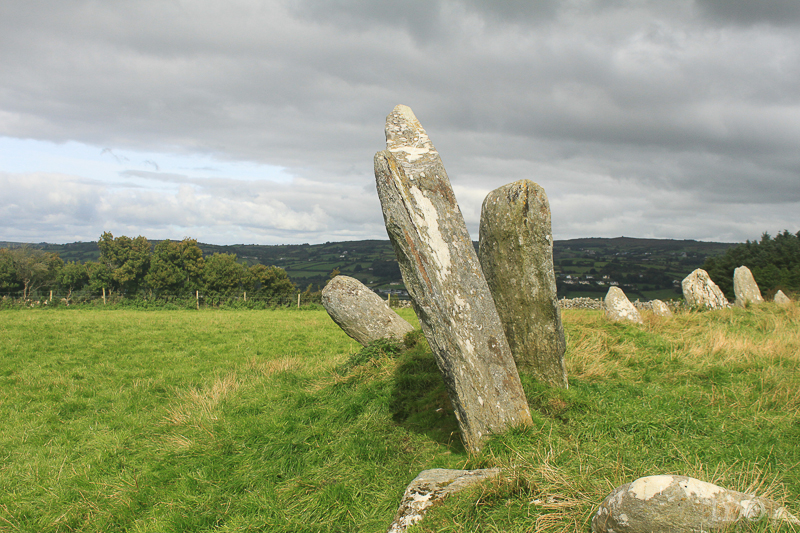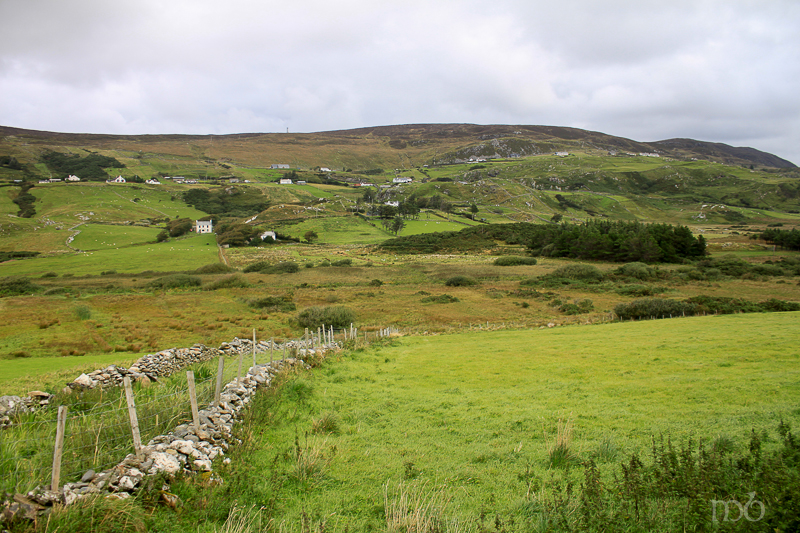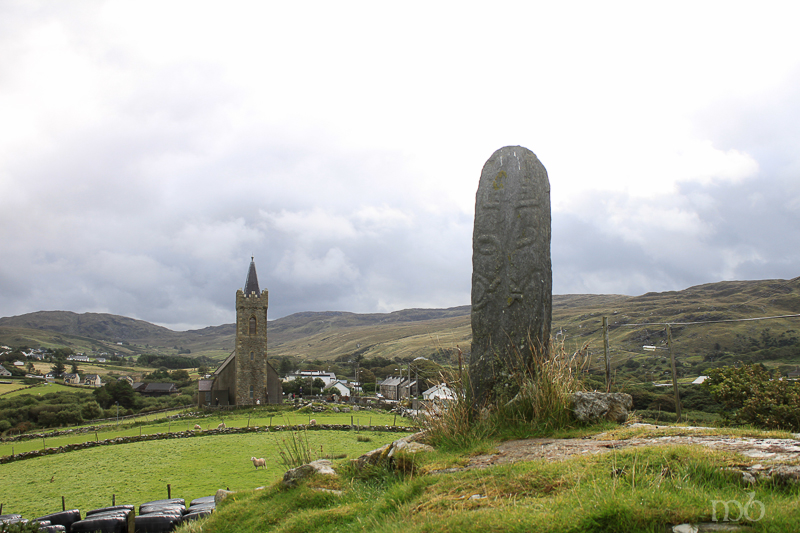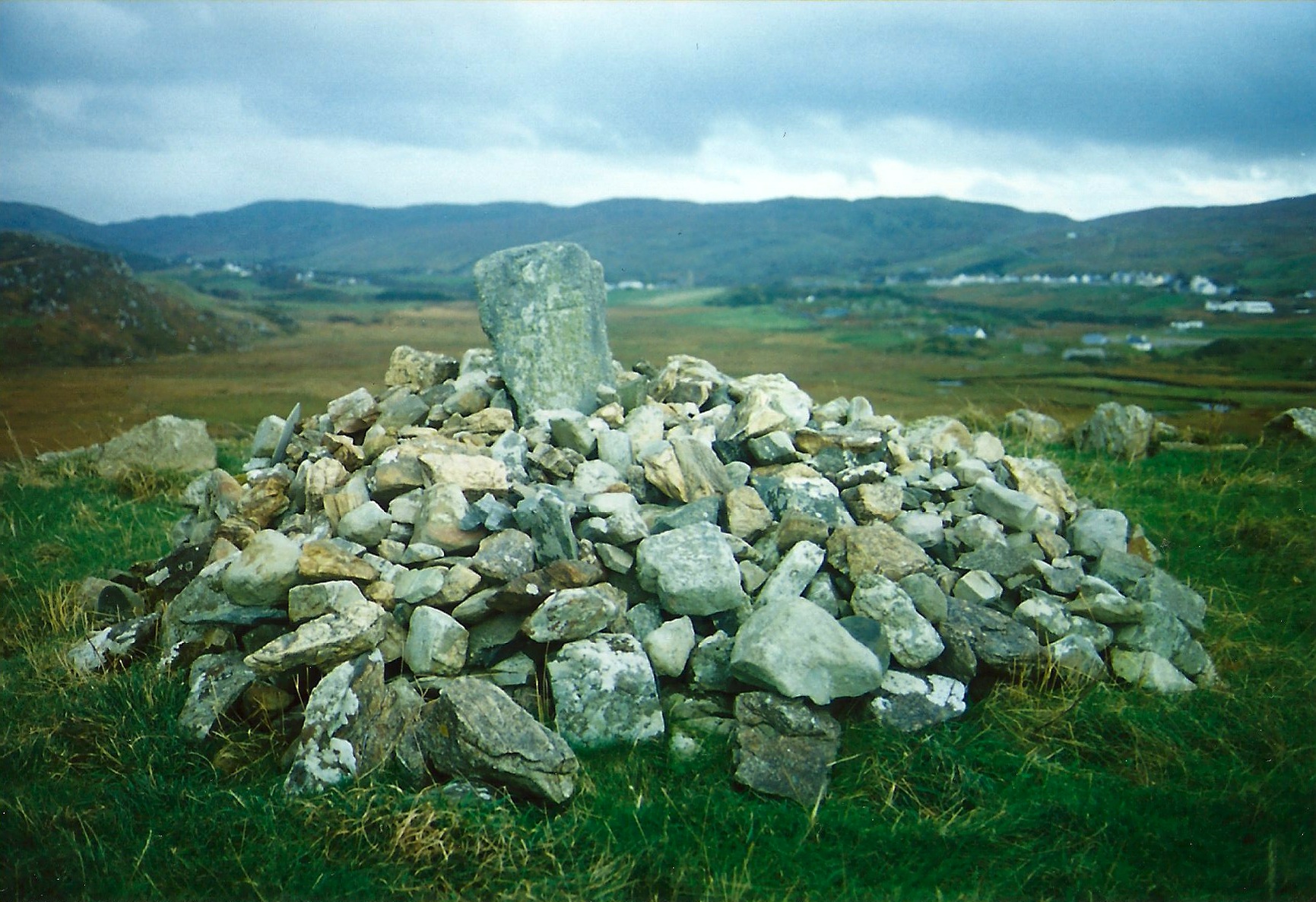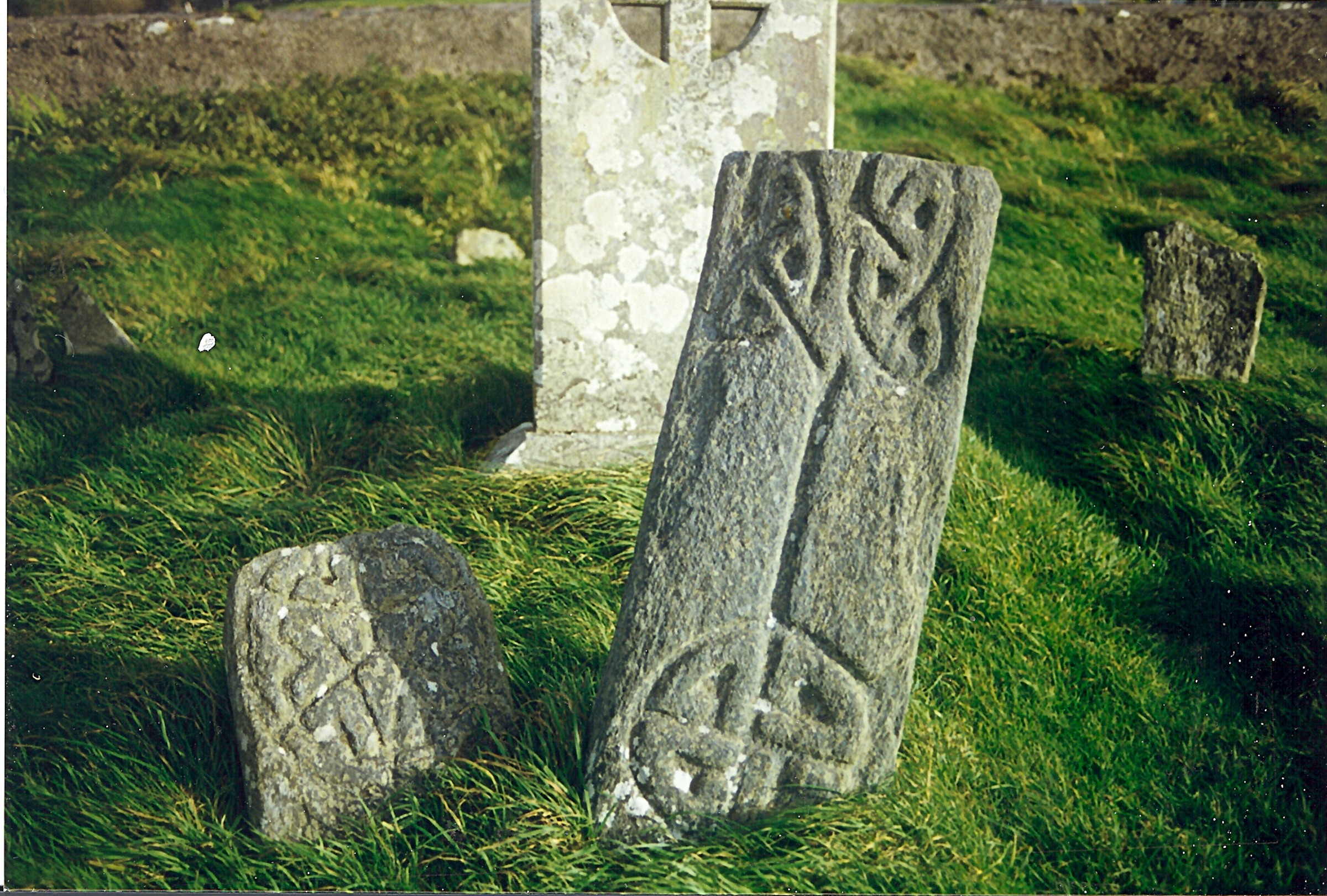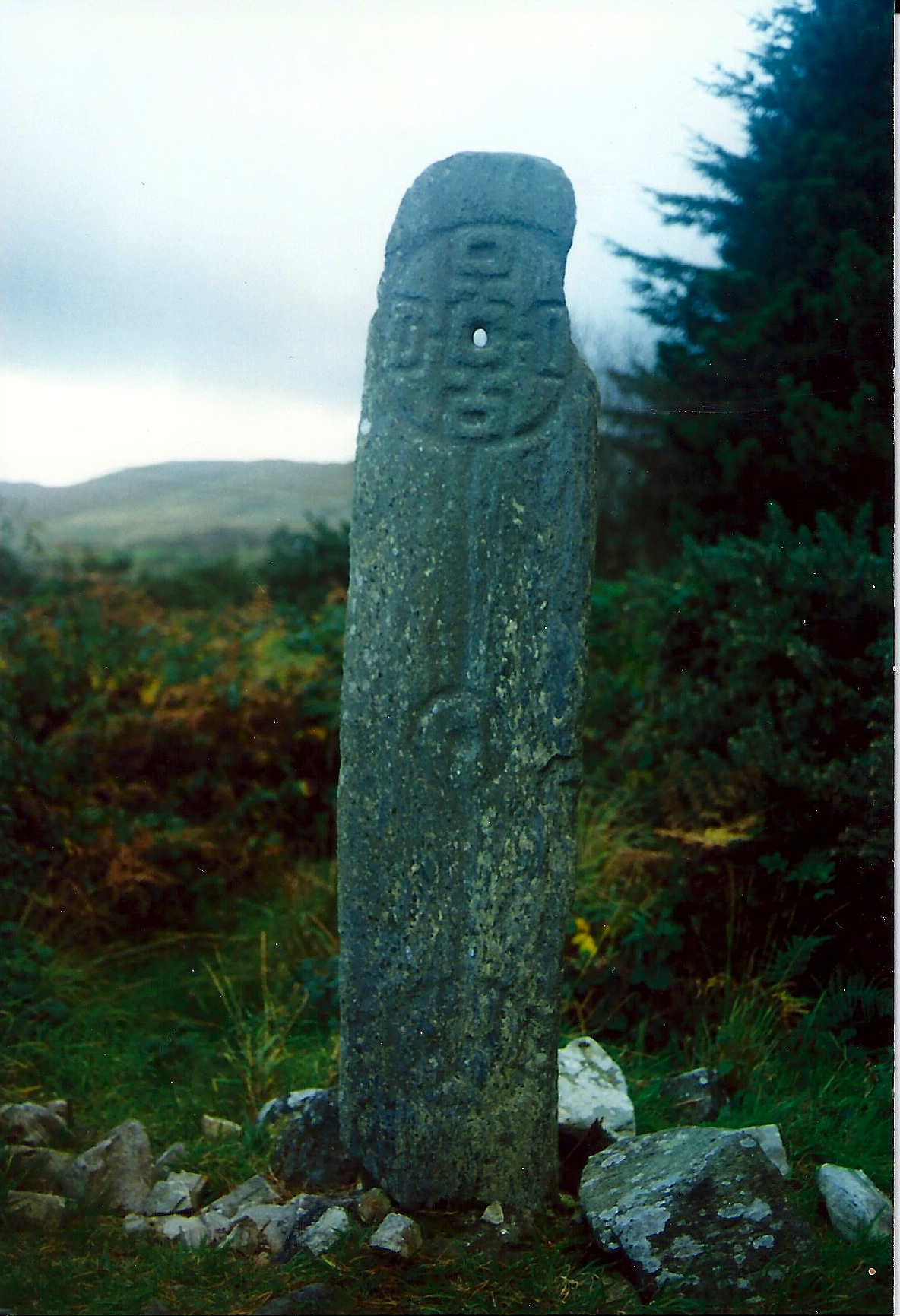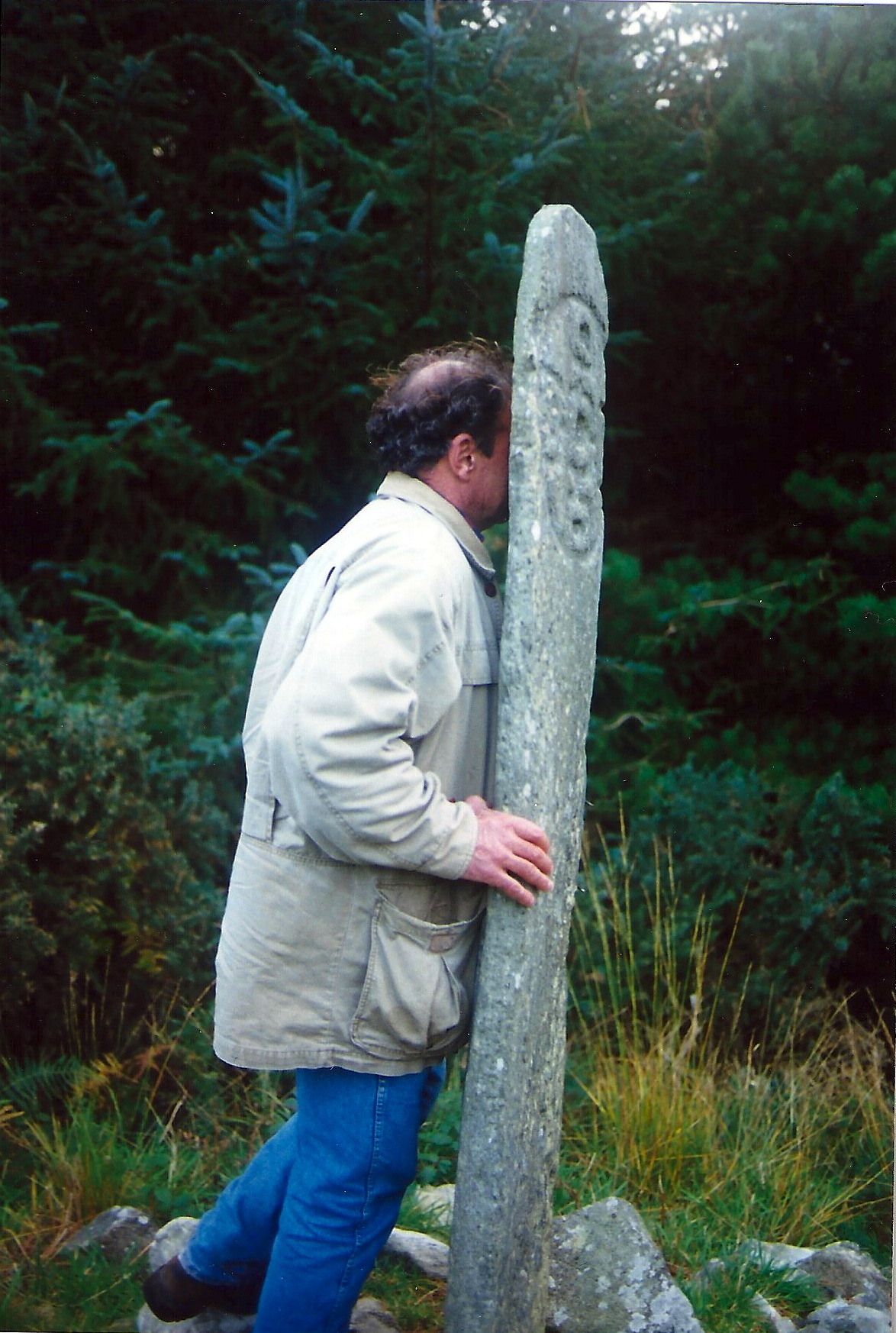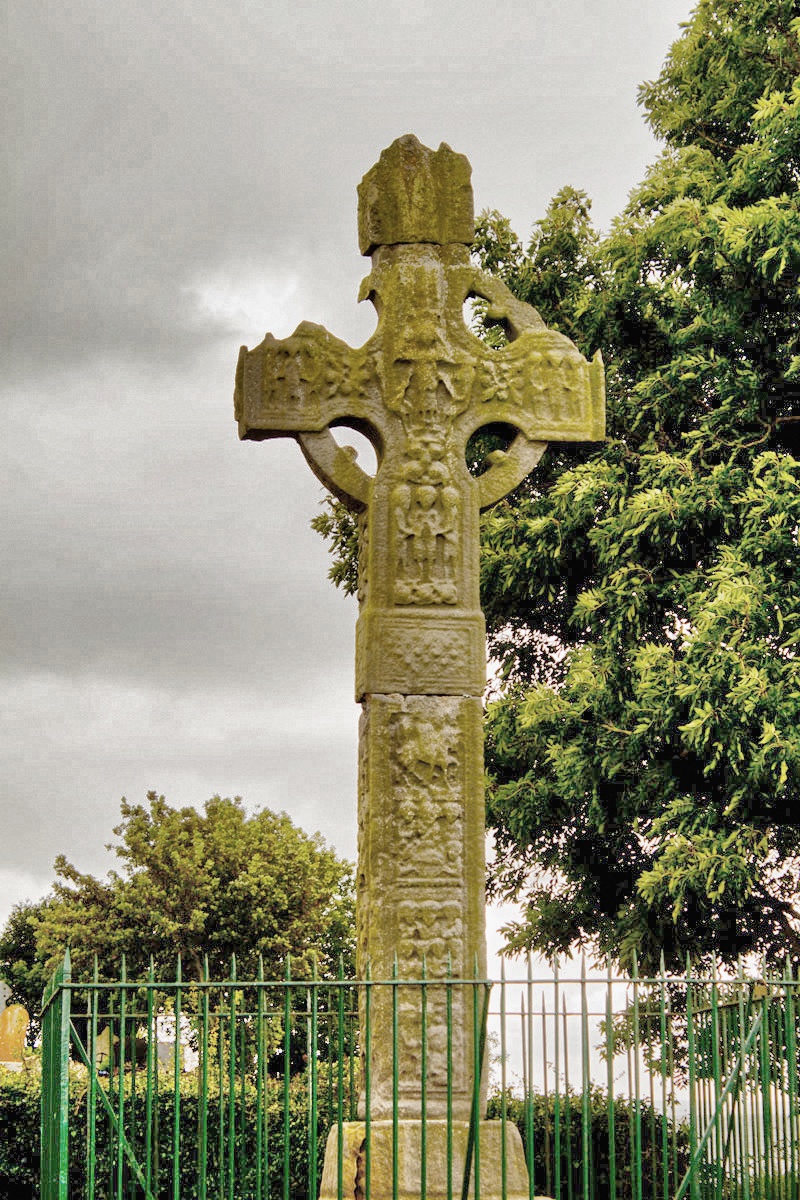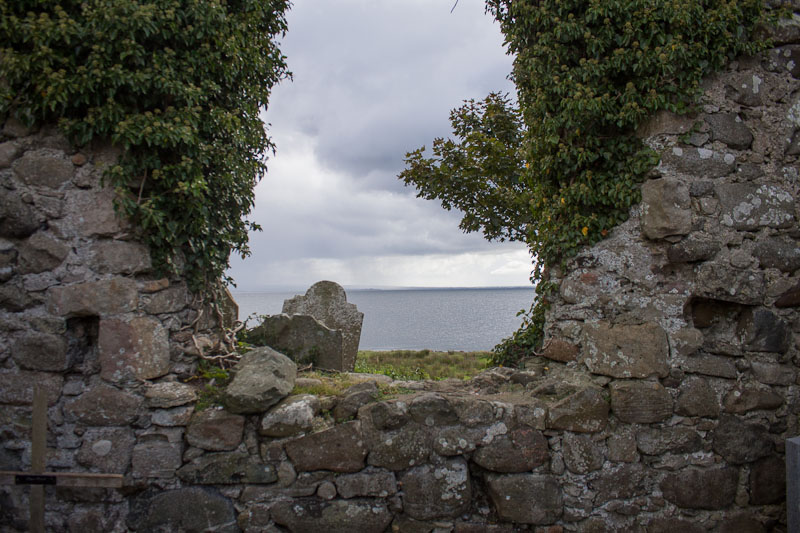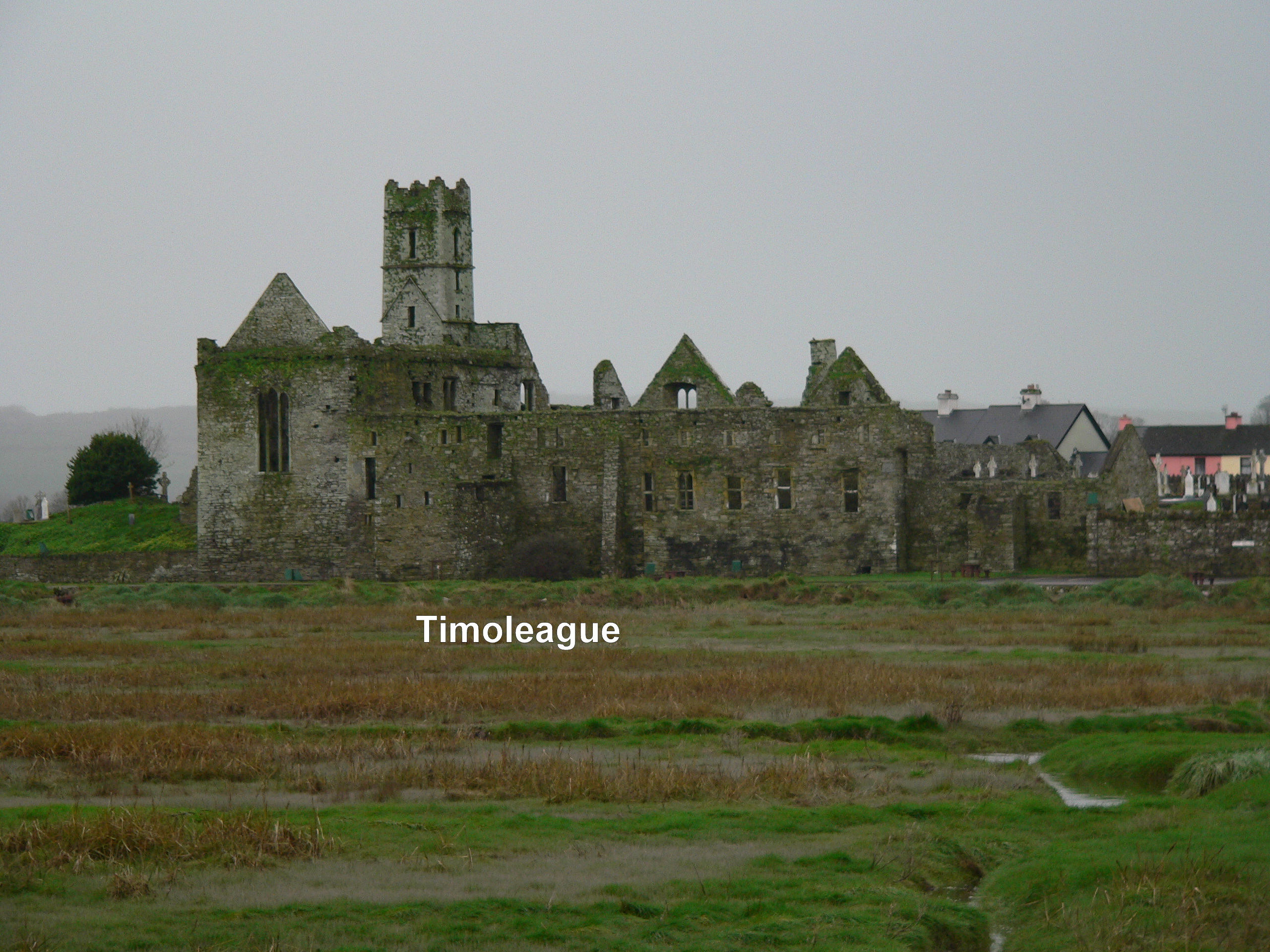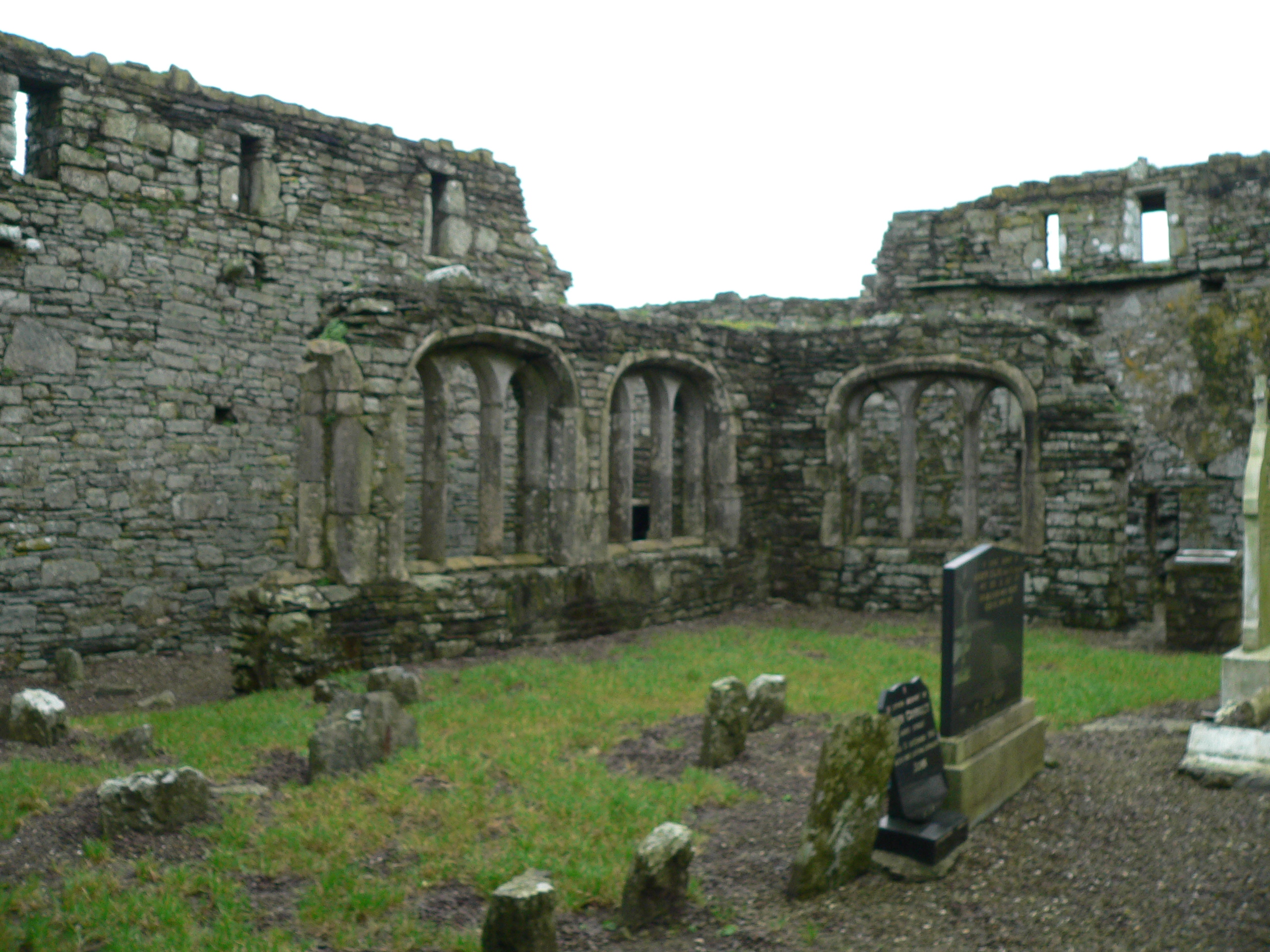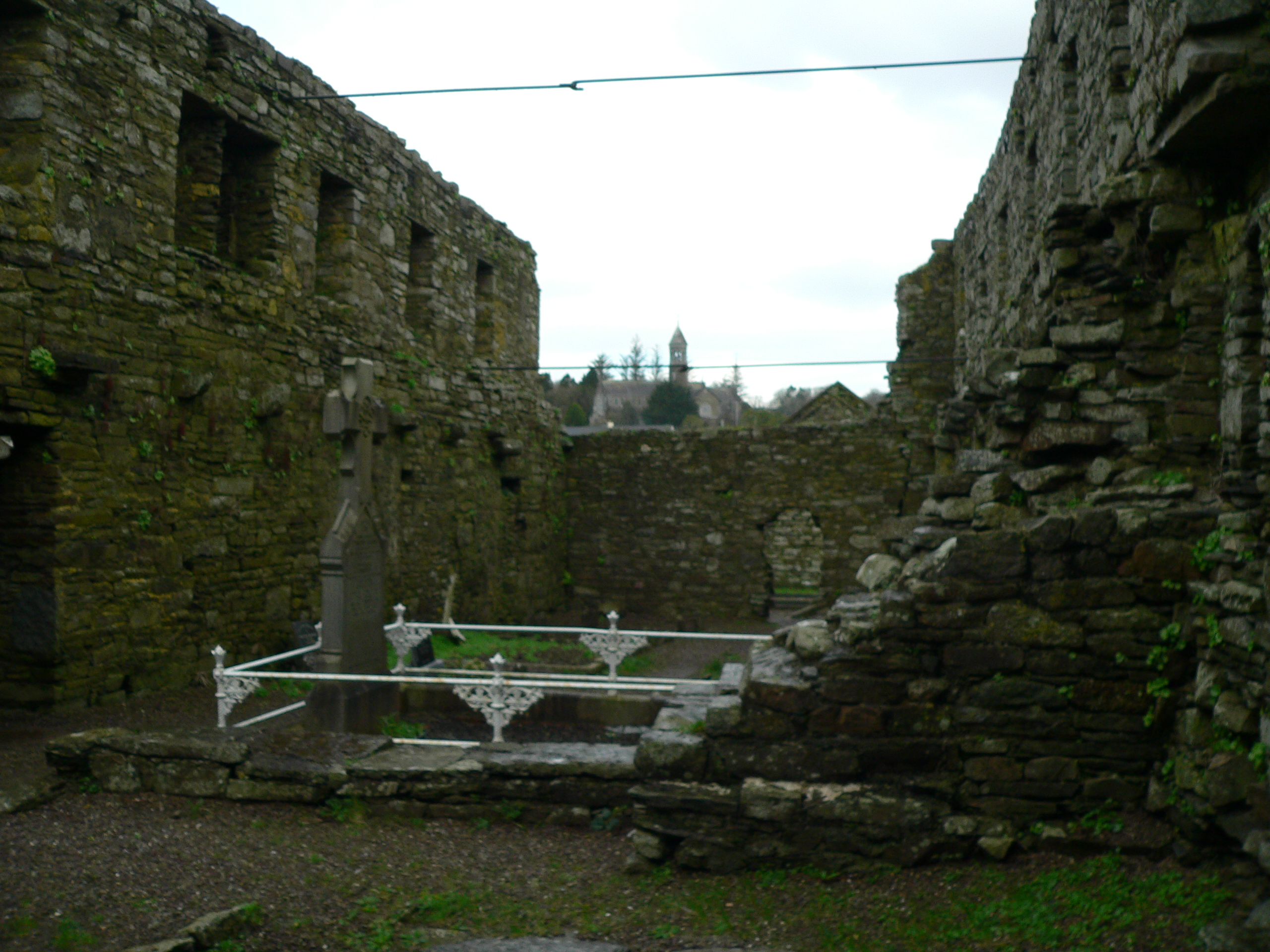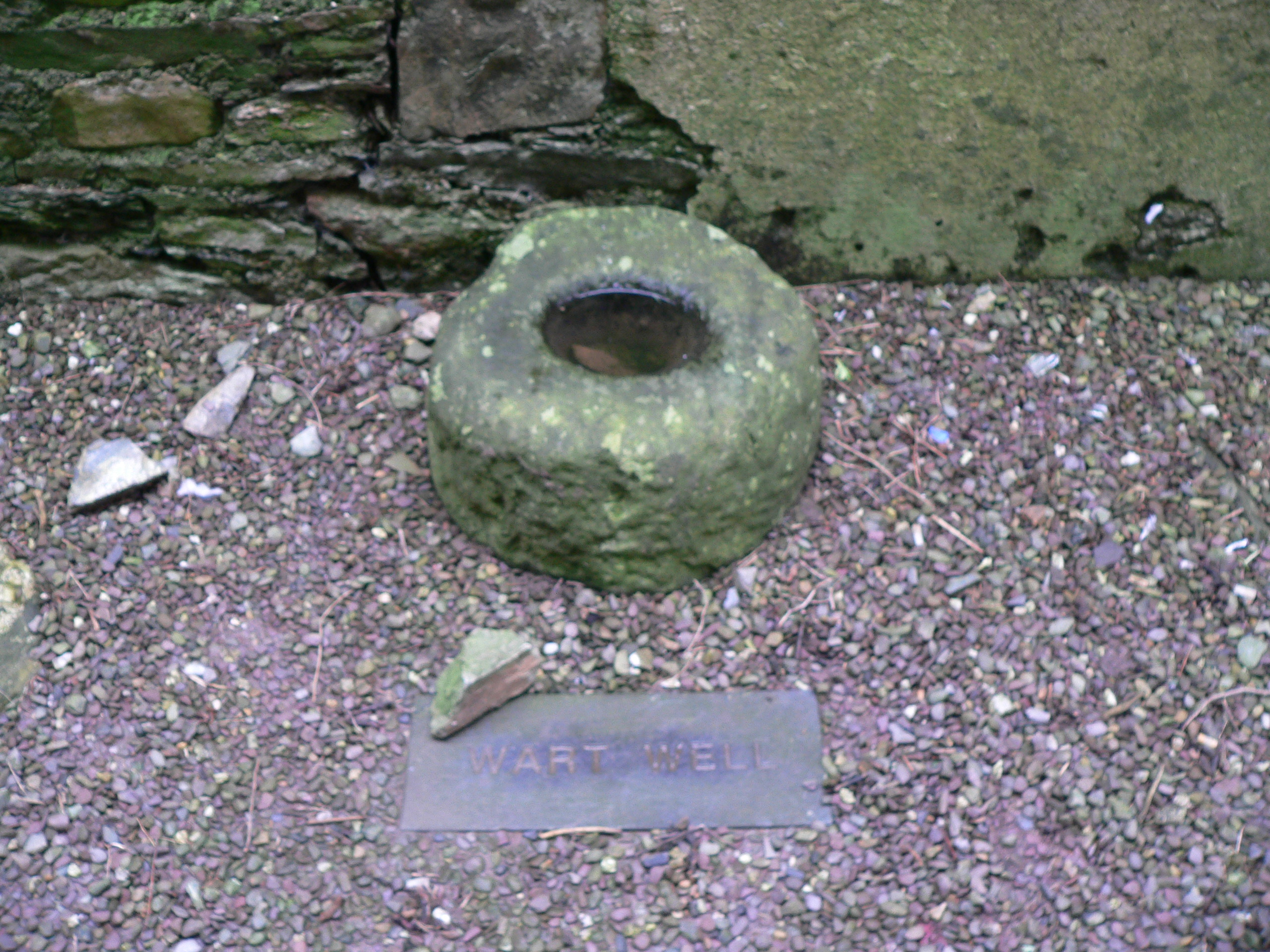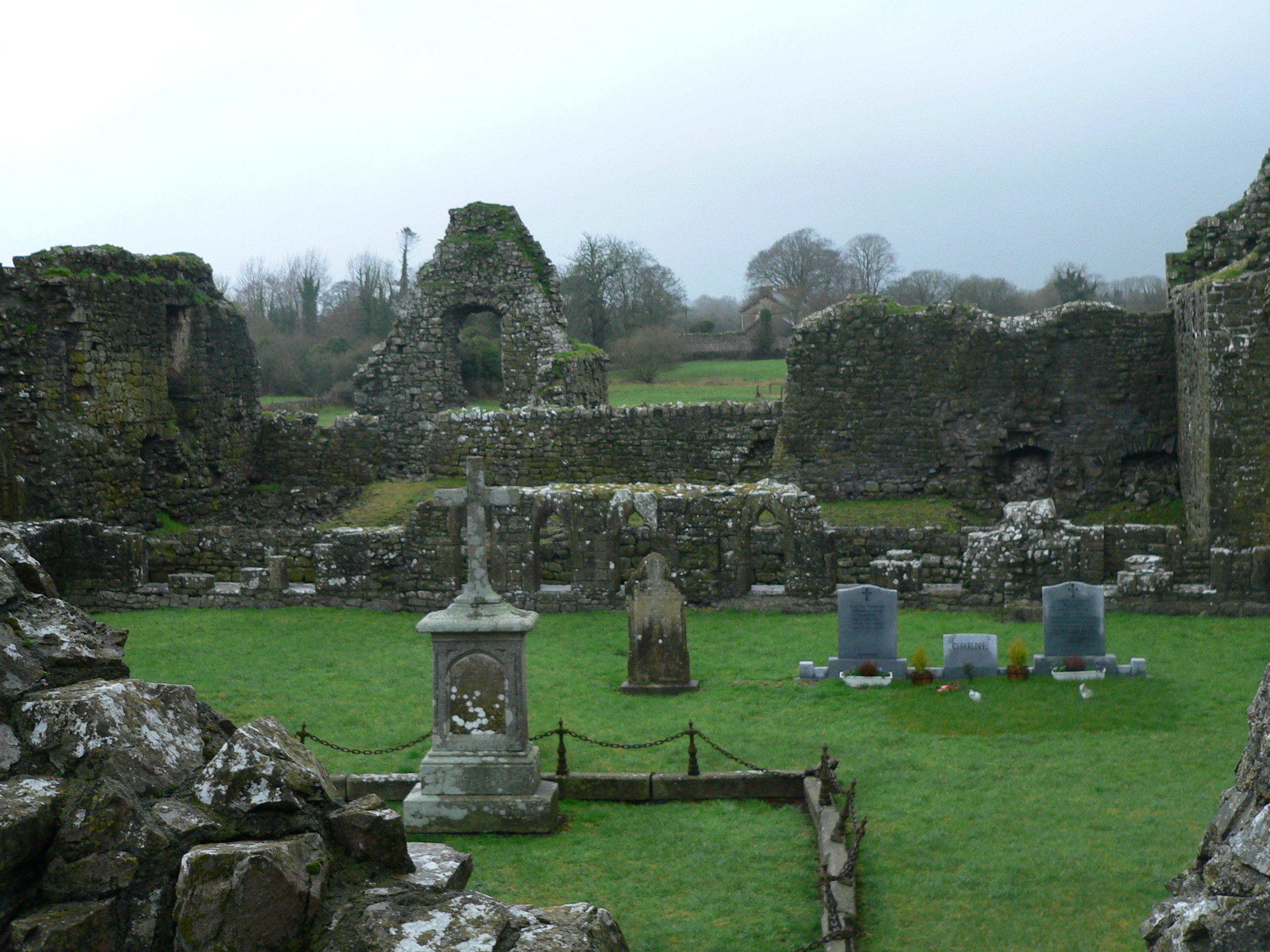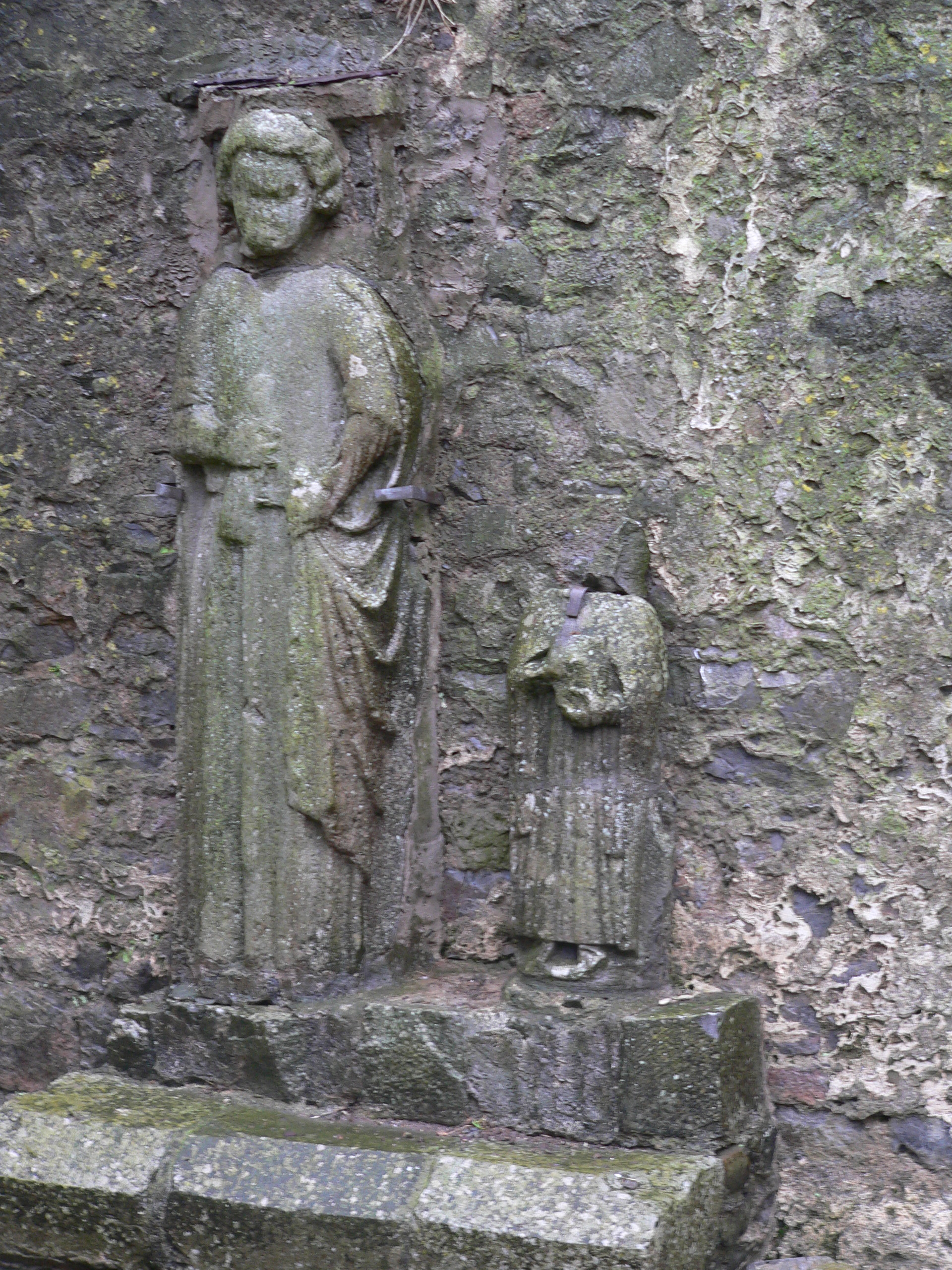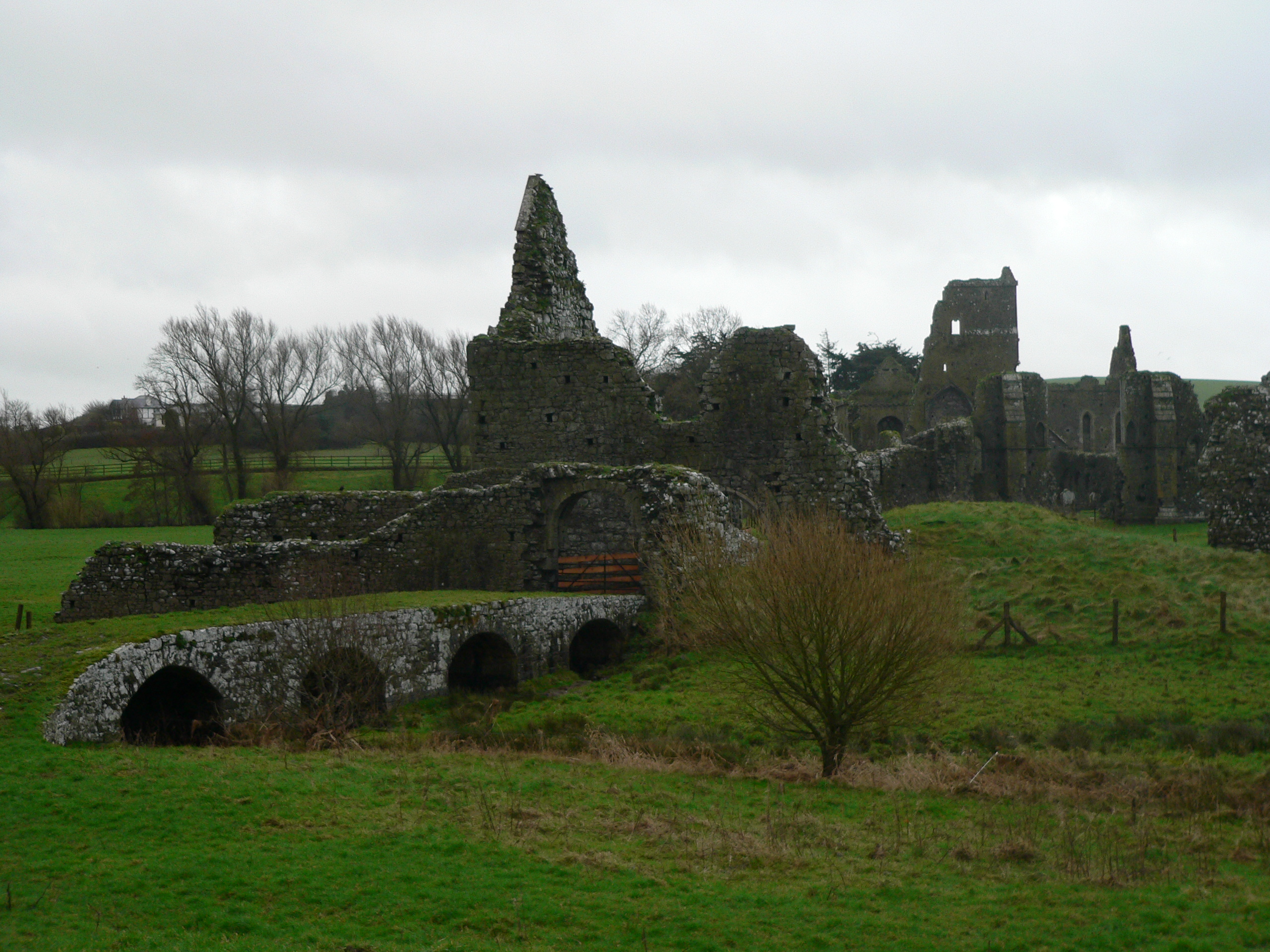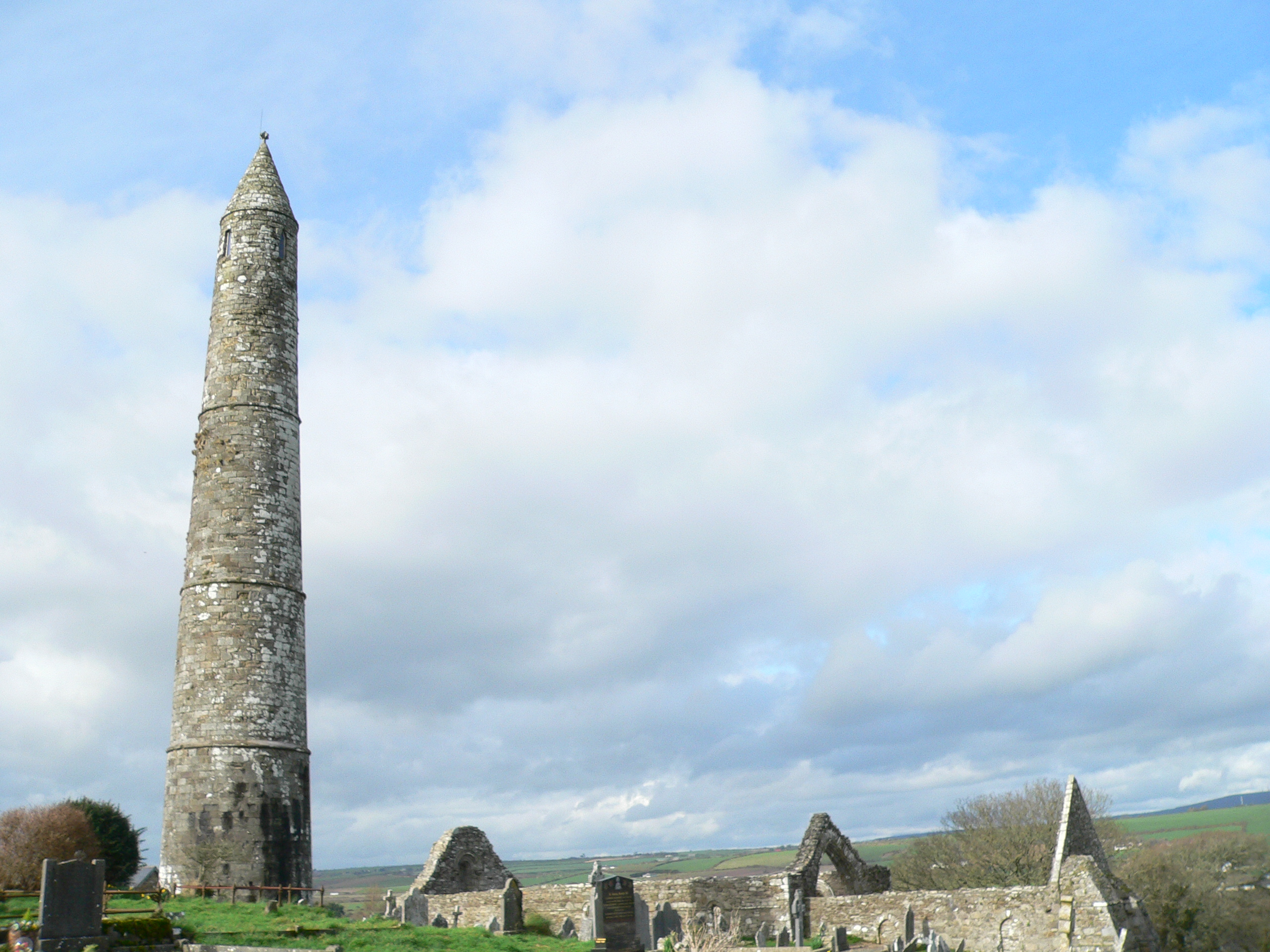Inchmahome Forest Walk – Stirlingshire, Scotland
Inchmahome Forest Walk Ancient Trees
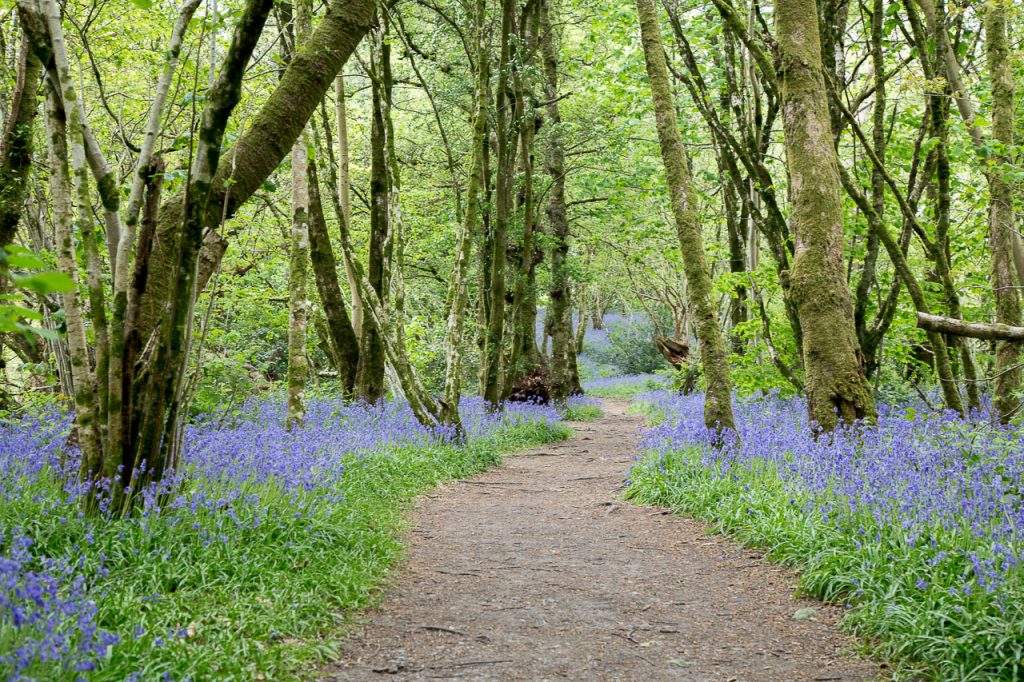
Inchmahome is a tiny island in the Lake of Menteith, which lies about halfway between Aberfoyle and Callander at the edge of the Loch Lomond & Trossachs National Park. The island is covered with trees and has a remarkable Forest Walk, but it also houses the ruins of an old 13th-century priory that sits in the center of the island.
Inchmahome, though small and only one of the scores of monastic communities that were scattered around Scotland, had some famous visitors. Robert the Bruce visited in the 1500s as did King Robert II. The most romantic visitor tales are center around Mary Queen of Scots, her mother, Marie deGuise and the “Four Marys” who served as Princess Mary’s ladies in waiting. Marie deGuise sought refuge at the Inchmahome Priory for five-year-old Mary Queen of Scots during military conflicts between Scotland and England that put the little princess’s life in danger. Old legends say that child Princess planted the Spanish Chestnuts and that those majestic trees can conjure the spirit of Mary Queen of Scots onto the island from time to time.
Two Minute Video of the Inchmahome Forest Walk – Trees Have Faces
There are many species of trees – perhaps the most famous are the Spanish Chestnuts, which are said to date back to the 1500s. They’re not easy to miss. They are the royalty of this forest and exude an energy that one can almost hear in the wind. If you relax your eyes and gently stare at these chestnuts, their aura is soon visible – gold, radiant.
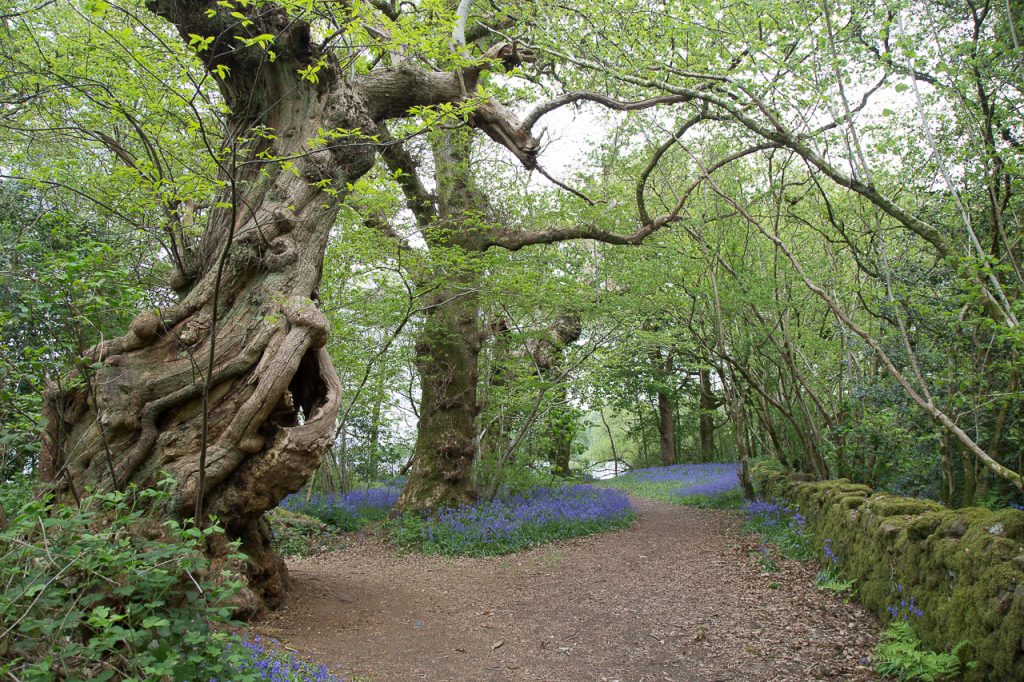
Forest Walks – Do the Trees Have Faces?
It’s interesting how fairy tales and folklore set the scariest stories in forests. Why are forests so scary? Perhaps it isn’t the forest that is scary. Perhaps it’s that our own minds that become keenly sensitive to otherworldly things when we are completely surrounded – above, below and besides – by nature, uninterrupted by development or the outside world. Something happens to our senses when we are immersed into that fury of elemental life. In fairy tales, the trees sometimes come alive – have faces – arms – and attack the forest walker… or worse.
I’ve noticed that when I walk in some forests quietly alone, after about 20 minutes I notice the details I couldn’t see before. The shapes of the branches, the colors, the textures…. and in some forests, the trees come alive with faces and human characteristics. Such was my experience at Inchmahome.
The forest became Otherworldly. It’s places like these where we can absorb the energy, the healing, the insight that comes with walking in thin places.
This little forest is worth visiting even if it’s the only thing you see in Scotland.
The Lake Hotel on Lake of Menteith
Our friends own the Lake Hotel on the shores of the Lake of Menteith and the boats that go out to Inchmahome are a short walk from that Hotel. This is where we stay during this leg of our Scotland tours because guests can savor that sense of “a thin place” for a while.
Kildare – St. Brigid’s Holy Well (Tobar Bride)
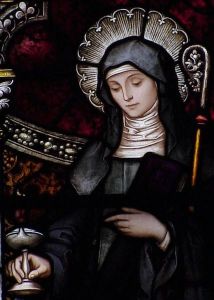 Legend tells us that St Brigid was born near Kildare to a slave mother who was a Christian and very sickly. As a child, Brigid persuaded the Druid master to free her mother which in turn freed Brigid to enter religious life.
Legend tells us that St Brigid was born near Kildare to a slave mother who was a Christian and very sickly. As a child, Brigid persuaded the Druid master to free her mother which in turn freed Brigid to enter religious life.
Kildare is one of the stops on the Thin Places Mystical Tour of Ireland – Castles, Saints & Druids in September 2014.
Since there were no convents in Ireland, Brigid began one in Kildare. The sisters of St. Brigid prayed simply and deeply and served the poor. We know that Brigid was a contemporary of St. Patrick and a strong legend states that she was ordained a bishop because of her superior knowledge and closeness to God.
Another legend is associated with the goddess or holy woman, called Brigid dating back to pre-Christian times in this region. Stories of the two women have been woven and spun into legends and tales that all point to a holy woman, who drew followers to this site and performed rituals that were associated with healing, protection, comfort and help for the poor. The town of Kildare grew up around the community that this woman – Brigid – founded.
Kildare translated means “cell” or church of the oak. Oaks were known to be sacred trees in pre-Christian Ireland which gives weight to the pagan or goddess tradition of Brigid. But it is believed that a Christian woman named Brigid founded a community here around 480 AD, that she was a contemporary of St. Patrick and was recognized for great spiritual wisdom. There are legends that she was ordained a bishop in the church due to her wisdom.
Brigid is now one of Ireland’s patron saints, and is often linked in patronage to farmers and poor pastoral workers – the common citizen, the oppressed Irish tenant farmer of past centuries. It is possible – some say likely – that St. Brigid located her religious community on the spot where the Kildare Cathedral is now situated. 13th century buildings now occupy the spot along with the second tallest round tower in Ireland and an oratory and fire pit which likely date back to pagan times. Legend states that St. Brigid kept an flame burning in the fire pit continually as a devotion to the Holy Spirit. The perpetual flame is still cared for today by the Brigidine sisters who live nearby. For centuries this cathedral site has been a draw for pilgrims – a holy place, a place of spiritual strength.

Nearby is St. Brigid’s Holy Well, and the thinness of this place is palpable. This is actually a secondary well, springing from a known ancient holy well a short distance away. Volunteers and benefactors have created a beautiful setting around St. Brigid’s Holy Well also known as Tobar Bride. A bronze statue of St. Brigid lifting the eternal flame has been added in recent years. Stone prayer stations lead from the well to a running spring.
Wells were considered holy by the pre-Christian Irish being that they sprung from the “underworld” or the womb of the earth. That tradition of holiness exists today. Water from holy wells is believed to have special power for healing and spiritual protection.
“A holy well is very special. To watch water springing from the earth is to witness creation in the act of pure, unconditional generosity. At a holy well, my own interior holy well has an opportunity to make itself known to me.” – Gay Barbizon, Brigid’s Kildare; The Fire, the Well and the Oak.
Upon entering Tobar Bride, the pilgrim can see a small devotional shrine where donations are publicly accepted and welcomed. The old pagan tradition encourages the pilgrim to leave an offering when taking water from the well.
Pilgrims are encouraged to say prayers at each of the seven stations at Tobar Bride. Just past the small devotional shrine is the spring marked by a stone arch. This is the first station. Water flows through two oval shaped stones. Some say these stones symbolize the breasts of the earth – our mother. The bronze statue of St. Brigid is near to the arch.
Past the arch are five standing stones or “stations” that represent a part of Brigid’s nature. Pilgrims pause and recognize these qualities and perhaps pray for the same graces to develop in their own lives.
First stone – Brigid the woman of Ireland, the patroness, the protector of a beloved country.
Second stone – Brigid the peacemaker, healing division, bringing forward unity.
Third stone – Brigid the friend of the poor, advocate of the marginalized, speaker for they that have no voice.
Fourth stone – Brigid the hearthwoman, keeping the home flame burning, welcoming all, woman of hospitality.
Fifth stone – Brigid the woman of contemplation, which leads to wisdom and closeness with the Creator.

St. Brigid’s Holy Well – Kildare
The holy well behind the five standing stones marks the 7th station. It is here that one can pause and reflect, pray for a loved one, and draw water – perhaps to take to a loved one who is ill or to bless a home.
It is traditional belief that a person taking something from (holy water) from a devotional site should leave something behind. Notice the tree behind the well. Dangling from its branches are stips of cloth and other tokens – also known as “clooties” – that have been left behind by pilgrims. The cloth may have been touched to the person for whom the pilgrim is praying. Sometimes pilgrims leave photos or personal belongings behind – things that have touched the person they are praying for. This tree had a baby’s shoe dangling from a branch.
The pastoral setting of this park-like devotional space is near the Curragh – or places where the thoroughbred race horses – famous in Kildare – run and are kept. It is almost impossible not to be moved when entering this space.
This is a very Thin Place.
An Ephipany in Ireland – Why do I Keep Going Back?
Every year we travel to Ireland with a few guests and we share with them some of our favorite thin places, mystical places where the veil between the two worlds is thin. I’ve been traveling to Ireland for the last 20 years and when I add up the expense of this travel it would have paid for a trip around the world … but I keep going back to the same country. Why?
One of our guests on the 2013 Discover the North tour was a personal friend. He asked me if I was going to do tours to other thin places – Scotland maybe …. perhaps Wales or France or Russia. Certainly these countries had thin places.
I didn’t have an answer. I wondered for months about what he said. Maybe Ireland was just too easy. Maybe I was too comfortable with the familiar.
My husband agreed. He was open to expanding the thin places field of travel. With these thoughts in mind I traveled to the North last September secretly expected it would be my last trip to Ireland for awhile. It was time to move on to other thin places.
GLENCOLMCILLE
Our Discover the North group’s first two days were exciting and a little stressful with getting everyone settled in. By the third day we all knew each other and the schedule was a bit more relaxed. On day 3 half our group went fishing while the other half took a leisurely drive through Glencolmcille, a gorgeous, rural village in hills of County Donegal where St. Columba founded a monastery and pilgrims have been coming for years.
There’s a church in the valley – right in the middle of the glen. St. Columba’s Church. And just outside the church yard is a standing stone, a way marker that serves as one of the turas on the Glencolmcille pilgrimage. The group got off the bus at this church and scattered across the church yard and neighboring fields.
I took a moment to walk behind the church and take in the landscape. In one single moment a feeling I can’t describe swept over me. I knew why I kept coming to Ireland. There’s a connection to the land for me. Though I’m not native to Ireland and I’ll never leave my home in Maryland permanently, there’s something about Ireland – especially in the North – that connects. It means something.
I grow and change with every visit. I learn something new. I see something new. I discover some new truth with every visit.
So we’ll be returning to the North the year in May with another group. I got so enthusiastic after last years tour that I scheduled two tours to Ireland this year.
France, Scotland, Wales and Russia will have to wait.
St. Columba and Glencolumbkille
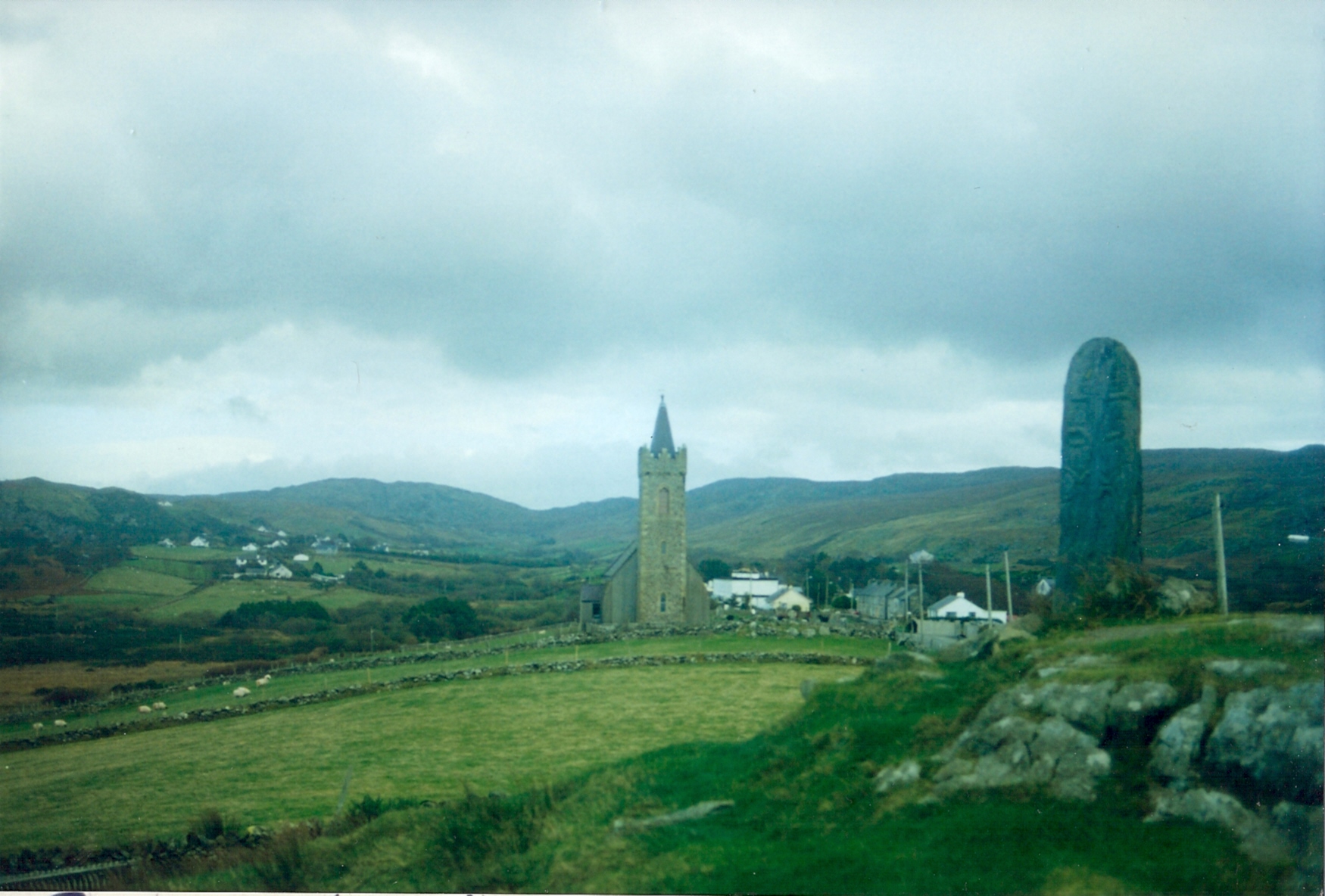 Glencolumkille is a rural parish in southwest County Donegal. It is most known for its pilgrimage that honors the patron saint and protector of Donegal, St. Columba. There are many variations of his name (Columbkille, Colmcille). The Pilgrimage of St. Colmcille, also known as the Turas Cholmcille honor the saint while personally drawing his blessing and strength by walking in his footsteps across a land that was once his home. There are 15 stations scattered throughout an enchanted glen – each marked by a pillar stone or cairn or some type of stone marking.
Glencolumkille is a rural parish in southwest County Donegal. It is most known for its pilgrimage that honors the patron saint and protector of Donegal, St. Columba. There are many variations of his name (Columbkille, Colmcille). The Pilgrimage of St. Colmcille, also known as the Turas Cholmcille honor the saint while personally drawing his blessing and strength by walking in his footsteps across a land that was once his home. There are 15 stations scattered throughout an enchanted glen – each marked by a pillar stone or cairn or some type of stone marking.
My favorite definition for “pilgrim” was written by Paul Elie, found in his book The Life You Save May Be Your Own, a book about great writers and the power they have over us. Paul says, “A pilgrim travels within the context of a story, in order to be changed by the story.” The definition certainly fits the pilgrims who do the Turas in Glencolumkille.
To remember the story of St. Columbkille is to remember a man who was a descendent of the ruling tribe – royalty in his day. A man who was educated and tutored by the best scholars. Columbkille was a leader who could shape meaning from circumstances. He founded more monasteries and monastic communities than any other single Irish saint. But pride got the best of him when he was at his most powerful, and he picked an fight with another saint – St. Finian who had an illustrated psalter. St. Columbkille secretly copied St. Finian’s book so that he would have a copy for himself.
St. Finian was offended and demanded Columbkille’s copy. Columbkille refused saying knowledge gained from books should be shared not coveted, especially when pertaining to God. Finian took the matter to the High King for arbitration and the High King ruled in favor of St. Finian with a famous statement – “To every cow its calf and to every book it’s copy” meaning every calf belongs to its mother and every copy of a book belongs to the original book’s owner. Columbkille was outraged in losing the battle and this disagreement eventually led to Columbkille’s tribe attacking a tribe to the south which led to the slaughter of over 3000 people.
Columbkille was so ashamed to have been the root of so much death and destruction in his native land, that he sent himself into voluntary exile. He sailed from his beloved Derry to Scotland landing with a few followers on the island of Iona where he established a community which flourished into a great seat of learning and spiritual growth. Iona still has a community there and it continues today to draw pilgrims.
So as the pilgrims travel through the station in Glencolumbkille, they reflect on the saint’s life, his strength, his weaknesses and his devotion, and they ask his blessing for own lives. Every station has a ritual, a prayer to be said, a devotion to be made. So that when the turas are all done, the pilgrim has drawn strength from both the story and energy of the land.
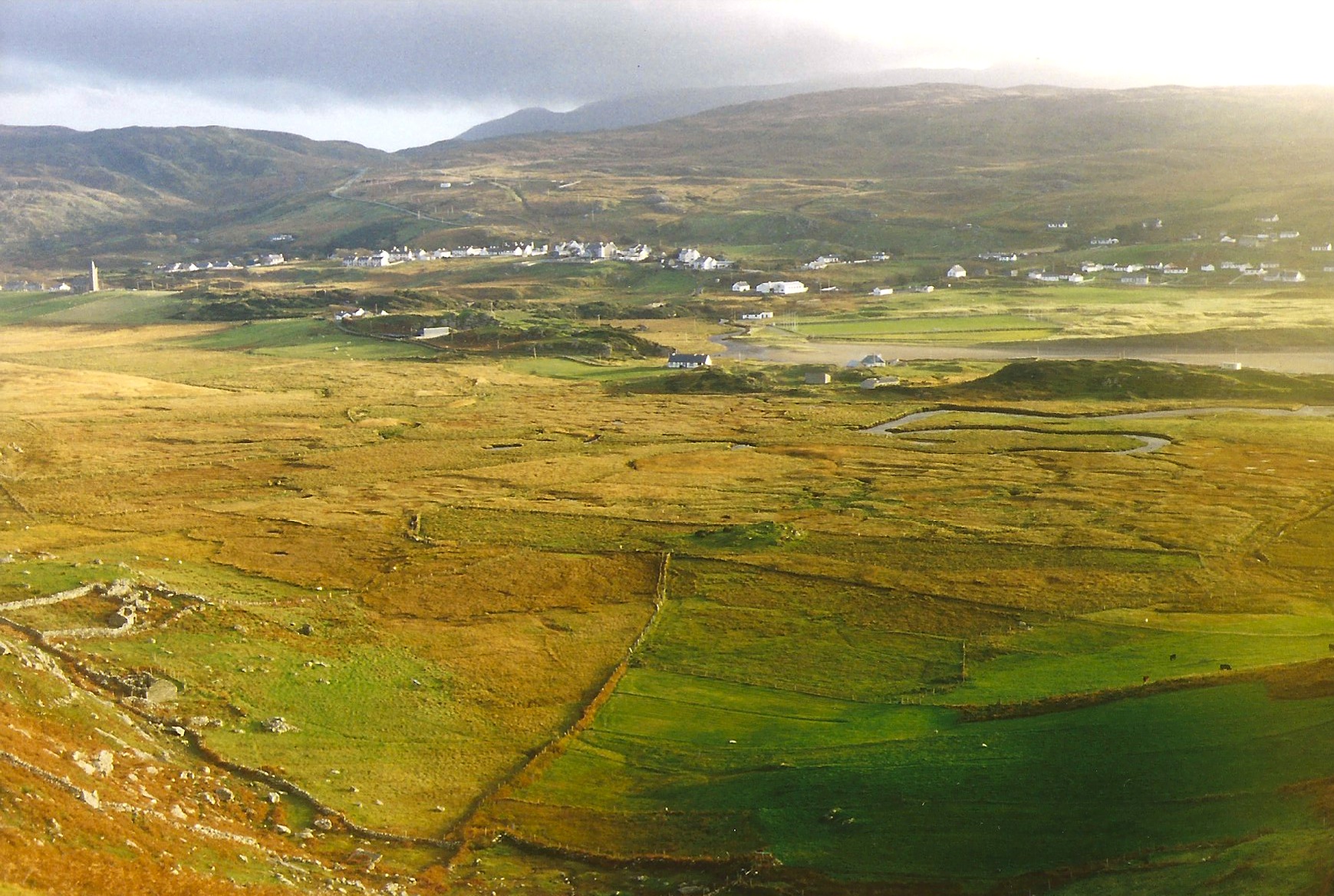 The land has been considered sacred for thousands of years. Devotion and ritual in the glen dates back thousands of years. Portal tombs dating from 2000 BC can be found in the glen as well as court tombs the date to 4000 BC. The land in Glencolumbkille has an energy that early civilizations felt … that has lasted until the present day.
The land has been considered sacred for thousands of years. Devotion and ritual in the glen dates back thousands of years. Portal tombs dating from 2000 BC can be found in the glen as well as court tombs the date to 4000 BC. The land in Glencolumbkille has an energy that early civilizations felt … that has lasted until the present day.
Though Ireland has suffered in recent years with abuses committed by Catholic clergy which has rocked the faith of many, there are still hundreds that come to the glen each year to do the rounds. This kind of joining of devotion, spirit, land and healing never betrays trust.
I visited Glencolumbkille shortly after I married my husband. Our favorite spot was the Stone of Gathering (Turas 9). This tall carved pillar has a hole in the top. The stone was tied to a tradition where engaged couples would intertwine their fingers in the hole while professing their love and commitment to each other before a gathering of community members. There is also a tradition that if you peer through the hole (as Dan is doing in the image above) you will get a glimpse of heaven. The view from where Dan is standing is breathtaking. There is a special energy around this pillar… a kind of loving, warm, peaceful energy.
At the southwestern tip of Glencolumbkille is Slieve League (Sliabh Liag) which is the highest cliff face in Western Europe. The monastic serenity that blankets the entire glen and its scenic surroundings moves from peaceful to powerful – back and forth – and the prayers of the pilgrim mirror that energy.
“…echoes of the centuries’ feet
That moved along the penitential stones
In all thy winds are sweet.
Here came my fathers in their life’s high day
In barefoot sorrow, but God knows the whole:
Not for themselves they fasted, but to lay
Up riches for my soul.”
Glencolumkille and Slieve League are stops on the 2013 Thin Places Mystical Tour of Ireland. Check out the itinerary.
Other Good Webpages on Glencolumbkille and the Turas
Voices from the Dawn – Glencolumbkille Turas
Megalithic Ireland – Glencolumbkille Turas
Ardboe – Mystical Site on Enchanted Lough Neagh
ARDBOE or Ard Bó – a thin place in County Tyrone.
In Irish the name means Height of the Cow. The Ardboe high cross stands 18 feet high on the shores of Lough Neagh. It has 20 scenes from the Old Testament carved into its shaft that are still quite clear even after centuries of weathering out in the elements.
This and similar high crosses throughout Ireland were teaching tools used by the monks for religious education. In the early days of the Church, few villagers or farmers could read, so the bible scenes on the cross were used as a way to illustrate the lessons of the new Christian religion.
St. Colman founded a monastery in the 7th century on this site and built a church. The name Ardboe came from a legend that the mortar used to build that church came from a magic cow that emerged from the lough (Lough Neagh) that had gone dry. The milk from that cow gave strength to the builders as well as the building. In the 16th century, that old church built by St. Colman gave way to a new church – a church that still stands today as a crumbling ruin on the shores of Lough Neagh, clinging to that holy space, drawing its energy.
Lough Neagh is linked to enchantment, believed to be a dwelling place for the fairies. One of tales of Lough Neagh’s origin is that Finn MacCool, the famous Irish giant from Ulster, was chasing his arch-rival from Scotland and the rival was getting ahead of him. Finn MacCool reached down and scooped up a handful of dirt and stone and flung it at the fleeing Scottish giant, missing him by miles. The dirt and stone fell into the Irish Sea and became the Isle of Mann. The hole left in the ground from where Finn scooped up the dirt, became Lough Neagh. The Lough is now the largest freshwater lake in Ireland and Britain, covering 151 square miles and touching five of the six counties of Northern Ireland. For centuries people have believed that its waters have healing powers.
The energy around Ardboe is palpable. It is likely that the land where the monks of St. Colman built the church was already identified as a sacred site. When approaching Ardboe cross and church, one is called to be still. The entire landscape of water, grass, trees and stone is knitted together with a kind of oneness that clings to its past — even while sitting in the present.
To approach Ardboe is to walk into that time of St. Colman and the time of the people before him who also worshiped and prayed at this sacred, thin place. I’m not the only who has felt that special energy of Ardboe. My friend, Maura Brooks, a native of County Tyrone so believes in the mystical energy of Ardboe that she brings travelers to the site on a regular basis. It is Maura who introduced me to Ardboe, and she’s produced a short video about it that give some great commentary from a local perspective.
Irish writer, Polly Devlin, who grew up near Ardboe wrote about the Arboe church site in the 1950s…
The position of the small primitive group of holy buildings silhouetted against water and sky affects us, and most visitors, to initial stillness and silence. The crumbling arched windows frame the perpetual movement of the small crested waves of the lough.
Ardboe is a thin place. It is a stop on our Thin Places tour of Northern Ireland in Sept. 2018.
Timoleague – Mystical Ruin on the Sea
Along the road between Kinsale and Clonakilty, near Courtmacsherry is the village of Timoleague which is dominated by the great seaside abbey ruin, a remnant of a 13th century Franciscan Friary. The abbey is built on the site of a former monastery founded by St. Molaga in the 7th century. Timoleague means – “house of Molaga.”
St. Molaga, as the story goes was a local boy who went to study the rule of St. Columba in Iona and then went on to Wales where he became good friends with St. David. He returned to Ireland and founded several monastic communities, but Timoleague was his greatest – and his last. He died here – probably of the plague. He and his followers were committed to helping those suffering from the disease when the plague hit Ireland in the late 7th century.
A story is told about how St. Molaga originally wanted to build his monastery farther up the estuary. But as he and his followers labored on the buildings by day, they all collapsed by night. St. Molaga took this as a sign that the Lord did not approve of the location. So he blessed a candle, lodged it in a rolled up sheath, set it alight and released it on the bay praying that God would help him find the perfect location for his new religious community. The candle floated until it stopped at the where the Timoleague ruin now stands. St. Molaga built his monastery on the sea and six hundred years later the Franciscans built an abbey on the foundations of St. Molaga’s monastery. The ruins of that monastery are what visitor’s see today.
I found this thin place through the recommendation of Mr. Noel O’Connor who was my host at Ashgrove Bed and Breakfast in Bandon. Over breakfast I asked him, “What is the most mystical place around here?” He was caught off-guard and hesitated. As a forma garda (police officer) I suspect he wasn’t invited to discuss “mystical” or thin places often. After pausing to give it some thought, he told me that many pilgrims go to Timoleague to pray and reflect. So I took his advise and I went to Timoleague.
What remains is a beautiful ruin now made into a comfortable public space on the scenic Courtmacsherry Harbor. When the monastery was active, boats used to sail right up to abbey, and the village grew around the activities focused there. Past the picnic tables and the stone wall are bones of the old religious house with haunting traces of how life existed there so many years ago.
Two favorite spaces for me were the dining room and the cloister walk. Pictured above is the cloister garth the part of a corner wall still standing. Monasteries typically had these square cloister walks with an open court-yard type garth in the center. The walks were the center of the the cloister and often used for doing “rounds” or walking and praying in a circular path. The walls bordering the garth had gothic-style windows to look out. I love to trace the steps of those who once walked and prayed here. On account I read said that at one corner of the walk the incorrupt body of a monk buried centuries before was discovered. He was reinterred on the grounds.
Another peaceful spot here is the refectory or dining area. It’s a large rectangular room off the back of the ruin with five tall windows (frames still in tact) looking out over the sea. Next to this area is a cavity wall, with indentations known as the fairy cupboards. It was from this room that children discovered an ancient book buried under one of the flagstones. They destroyed it and only the shred of the cover was found.
In the sacristy is the ancient holy water font, now known as the Wart Well. It is said to heal warts when those afflicted dip the warts into the water.
The monastery was sacked in the 1600s and three monks escaped by boat and took with them the Timoleague chalice for safe keeping. It was discovered in an old box in a home in the village many years ago and is now held by one of the priests residing in Timoleague.
In the distance behind the ruin a round tower (new) can be seen atop a church. This is the Catholic Church dedicated to the Nativity of the Blessed Mother. One of Henry Clark’s last stain glass masterpieces can be found here.
Timoleague is a haunting site full of mystery and charged with the energy of the past. It is one of the stops on the Thin Places Mystical Tour of Ireland in May of 2011.
Holy House of ivied gables
That wert once the country’s pride
Houseless now in weary wandering
Roam your inmates far and wide
~from Lament Over the Ruins of the Abbey of Timoleague
John Collins -1814
Athassel Priory – Golden, Co. Tipperary
A few miles southwest of Cashel in County Tipperary lies the ruins of Athassel Priory, a 13th century monastery on about 4 acres of land. The ruins are haunting when viewed from the road. It’s a very thin place.
The Lonely Planet Guide to Ireland refers to Athassal Priory as “…the atmospheric – and deliciously creepy at dusk – ruins.”
The ruins are set in a large field one must access by climbing over a wall from the roadside (at least this was true the last time I was there). It’s a massive ruin, but it’s interesting that Lonely planet called it “creepy.”
Athassel is one of the few places I have visited (and I’ve visited hundreds of monastery ruins) where I got an overwhelming sense of foreboding. Can’t say why. The place was beautiful but in this one spot I started to feel frightened, almost terrified. I turned the corner and saw this statue carved out of the ruined wall – St. Joseph and the boy Jesus… but Jesus’ head was removed. I moved away from that section and continued through the ruin. The intense fear subsided, but felt like I was being watched the whole time.
Strange. A very thin place.
The original buildings date back to 1205, and was founded by the Augustinians. Later it was occupied by the Cistercians. It’s original size alone denotes that it was a source of great wealth and a significant monastery in Ireland and it would have been surrounded by a large town – none of which remains. Still surviving within the ruin are an arched stone bridge approaching a portcullis gateway and gatehouse.
It’s easy to lose track of time at Athassel. One could wander for hours. The priory is a stop on our Thin Places Mystical Tour of Ireland scheduled for May 2011. Interested in attending? Check out the itinerary and book your spot.
The Rock of Cashel – St. Patrick’s Rock
The Rock of Cashel Rises from the Golden Vale
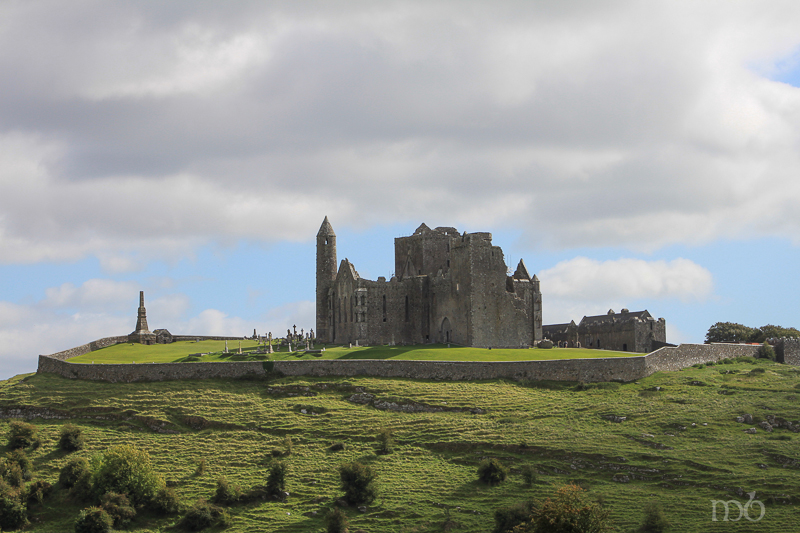
The Pre-Christian and Celtic people of Ireland, Scotland, Wales and England had a keen sense for thin places. The landscape in these countries is littered with man-made markings and ruins that remind the passer-by that this is holy ground. The rocks, trees and landscape hold the memories of spiritual exercises here long ago and present.
Cashel is a thin place.
The very ground itself seems to call out, “Come here and be transformed.” In a quiet moment, the pilgrim today can sense a connection with the souls that have marked these spots with their spirits. Cashel is a vivid reminder that we are all joined inside and outside of time.
The Tipperary Plain also known as the Golden Vale, spreads like a quilt of green and gold velvet patchwork, delineated by hedgerows, lines of trees and occasional roadway, and framed by distant Slieve Bloom Mountains. It’s called the Golden Vale because of the rich, fertile soil which brought prosperity to those who farmed it. Out of the center of the Vale, rising some 200 feet is the Rock of Cashel.
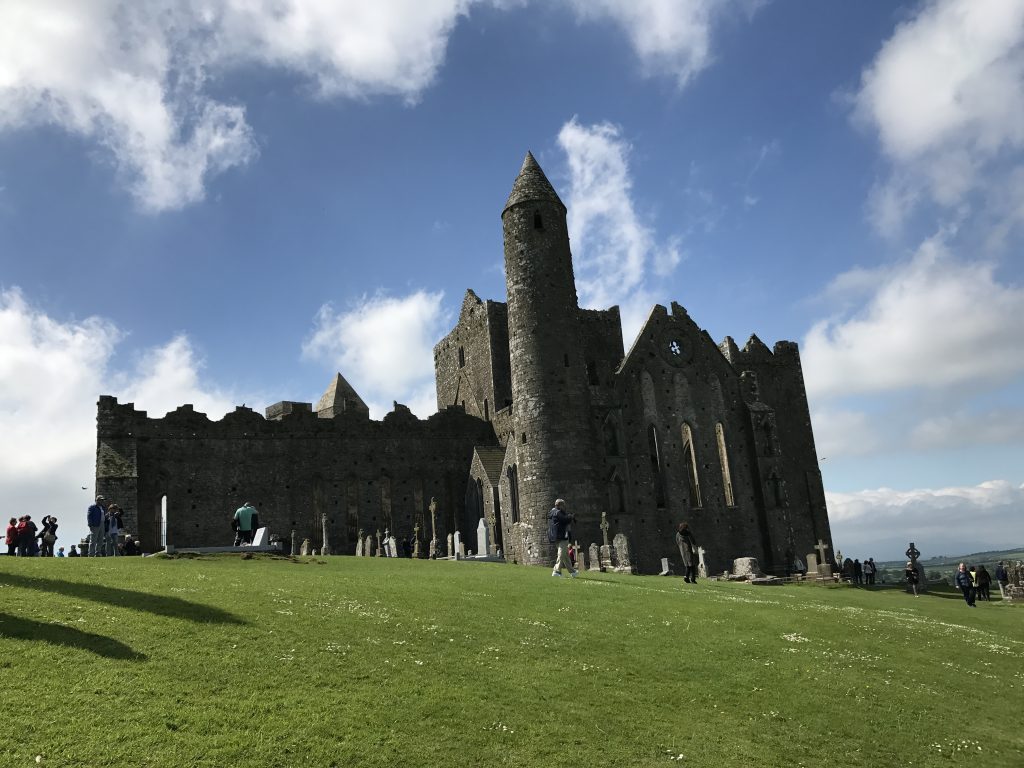
Crowned with the ruins of 11th and 12th century buildings, the Rock is woven into a series of legends, all associated with power and dominance that span nearly two thousand years. The Rock is also referred to as “the Devils Bit.” According to Irish legend, the devil was flying home (presumably to England) when in a fit of anger he bit off a piece of the Slieve Bloom Mountains and spewed it out into the middle of the Tipperary Plain, creating the Rock of Cashel. There is a unique “vacancy” in the hills around Cashel that looks decidedly like a bite. But the Slieve Bloom are comprised of sandstone and the Rock of Cashel of limestone, so the Devil’s Bit theory is unlikely.
St. Patrick’s Rock
Legend states that St. Patrick preached here in the fifth century. He came to convert King Aengus and baptized the King around 450 AD. Patrick later made Cashel a bishopric claiming it as a seat of power long before it was the seat of the high kings of all Ireland.
 In the twelfth century, a high cross, now known as “St. Patrick’s Cross,” was erected at Cashel to commemorate 800 years since St. Patrick’s visit. The original cross is quite weathered, but the image of the crucified Christ on the west face and the image of a man (possibly St. Patrick) on the east face can still be made out. The cross rests on a massive base repudiated to be the coronation stone of the Kings of Muenster. A replica of the cross and base greets visitors as they enter the enclosure on the Rock. The original cross and base are in the museum – also known as the Hall of Vicars, which also serves as the Visitor’s Center.
In the twelfth century, a high cross, now known as “St. Patrick’s Cross,” was erected at Cashel to commemorate 800 years since St. Patrick’s visit. The original cross is quite weathered, but the image of the crucified Christ on the west face and the image of a man (possibly St. Patrick) on the east face can still be made out. The cross rests on a massive base repudiated to be the coronation stone of the Kings of Muenster. A replica of the cross and base greets visitors as they enter the enclosure on the Rock. The original cross and base are in the museum – also known as the Hall of Vicars, which also serves as the Visitor’s Center.
The Rock, called Cashel of the Kings – Cashel is Irish for stronghold – dominates the surrounding landscape, its drama unparalleled in Ireland, and its history is every bit as dramatic. For one thousand years it was the seat of power for Irish kings and bishops, ruling the surrounding country, and for a time, the entire country. For 400 years it rivaled Tara as the seat of power for all of Ireland. The kings of Munster were crowned here and ruled from Cashel. In 978, Brian Boru declared himself High King of Ireland and was crown on the Rock of Cashel. He made Cashel his capital. Brian Boru was the first to unite all of Ireland with its centuries-long history of warring clans and tribes. He was also the last to unite all of Ireland, for since his death in 1014, no one person has unified the populations in all four provinces.
Boru’s descendants ruled from Cashel for one hundred years after his death when Murtagh O’Brien in 1101 gave the Rock of Cashel to the Catholic Church and it began to thrive as a Cathedral.
In 1647 the Earl Inchquin (under Cromwell’s influence) plundered the city. The townspeople fled to the Rock for safety and barricaded themselves in the Cathedral. Inchquin’s army piled turf around the cathedral and set it afire. All inside were burned to death. Over 800 people perished under that attack. The Rock was later abandoned, left to fall further into ruin. Finally, in 1874 it was declared a national monument and since then has been lovingly restored.
I will never forget the first time I saw the Rock of Cashel.
 At 10:00 a.m. we came down the Tipperary Road into Cashel. Seeing the Rock emerge from the landscape stirred childhood memories of seeing Emerald City rise up at the end of the yellow brick road in the Wizard of Oz. It was a moment when time stood still, burned in my memory like a trauma or birth.
At 10:00 a.m. we came down the Tipperary Road into Cashel. Seeing the Rock emerge from the landscape stirred childhood memories of seeing Emerald City rise up at the end of the yellow brick road in the Wizard of Oz. It was a moment when time stood still, burned in my memory like a trauma or birth.
That day we climbed the Rock of Cashel and wandered through the Cathedral ruins and cemetery. I knew nothing then about the history, who lived there, who ruled from there, what events took place there, but I knew it was a thin place. There was something exhilarating about Cashel, an excitement, a sense of power.
Cashel has long been linked with power. Warriors, chieftains, kings, princes, saints and bishops have all come here to mark the Rock as the seat of power, and blood has been spilled in that struggle for power. The Rock is not a peaceful place – as its legacy is riddled with memories of those who fought for power, stole power, ran to take refuge under the mantle of the powerful, and those who gloriously won the power.
The thinness is palpable. Your spirit is awake at Cashel.
I have returned to the Rock of Cashel with every visit to Ireland. I have seen the Rock lit up at night, covered in rain and mist, set against the frigid winter landscape and lingering through the long days of summer where the sun barely sets before rising again.
The Rock of Cashel, though in ruin, has a constancy; a historic brilliance that defies the modernization that grows around it with new homes, buildings and roadways. Cashel boldly claims her history, memories of kings, chieftains, warriors, bards, and holy men – thrusting them before us, urging us to enter in to her ancient legacy – and to return, and return and return.
So many people ask me, “What should I see on my visit to Ireland?”
I always say, “Don’t miss the Rock of Cashel.” Sadly, only a few heed my suggestion.
What a pity.
They’ll never know what I know… that Cashel will seduce you like a lover and cling to your spirit, planting some small charm that draws you back to her, creating a hunger for reunion. With each visit your are strengthened and sustained … until the next time. Cashel is like a first love. Though time, distance and life experience may stand between you – you never forget her, and you will return to her over and over in your imagination. You are changed forever for having known her.
Kilshannig – The North Side of Dingle Littered with Bones
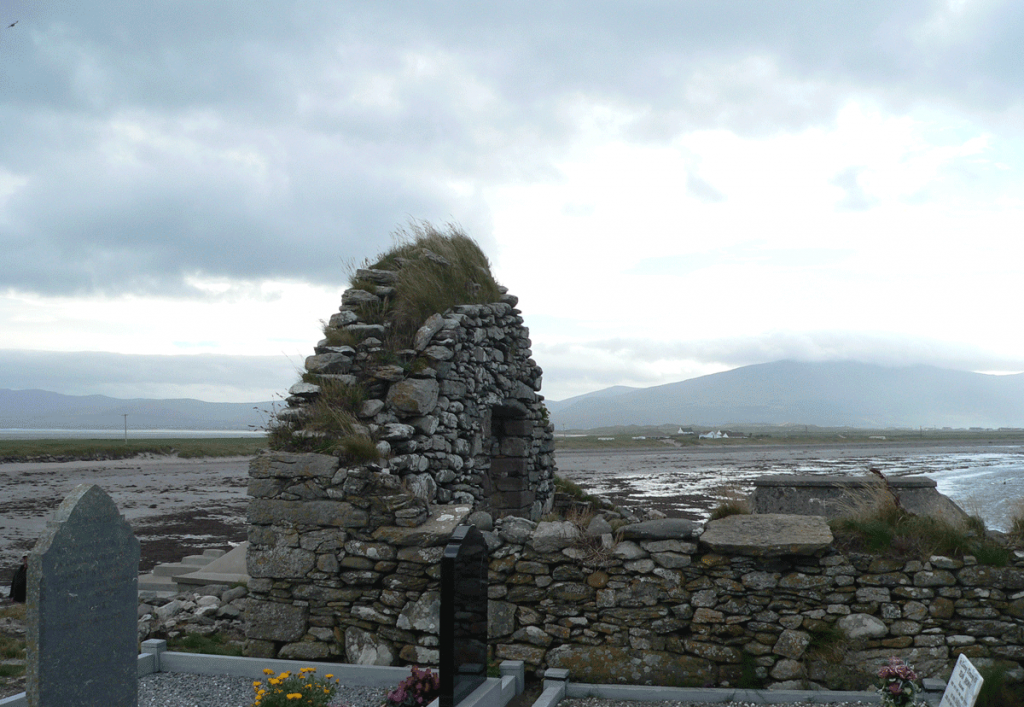
Church Ruin sitting on Brandon Bay in Kilshannig
One of the few places in Ireland I can photographically remember is Kilshannig, a small dilapidated village on the Dingle peninsula at its northernmost point. Most visitors that spend a day or less in Dingle seldom visit the northern route which has spectacular sea views, beautiful sandy beaches and commanding perspectives of Mount Brandon.
Just past Castlegregory is the turn-off to go out toward Rough Point. Kilshannig is a hilly village with a few small houses and narrow roads. We found cows wandering freely on the roadside and most of the buildings looked vacant. St. Senan or Seanaigh built a monastery in the Magharee Islands just off the coast of this village in the 7th century that was accessed by sea. A 15th century (some say earlier) church ruin now occupies the site at the edge of village overlooking Brandon Bay and the Atlantic Ocean. This little church was the mainland church for the monastery on the island.
7th Century Cross Slab – Kilshannig
Inside the church walls is cross-pillar slab from the 7th century. It has a Greek style cross carved on it and has been white washed. There are similar carvings on pillar slabs in Glencolmkille in County Donegal. It’s believed that the slabs were part of a pagan ritual before the area was Christianized. This may have served as a wayside marker. No one really knows for sure what these standing stones represented.
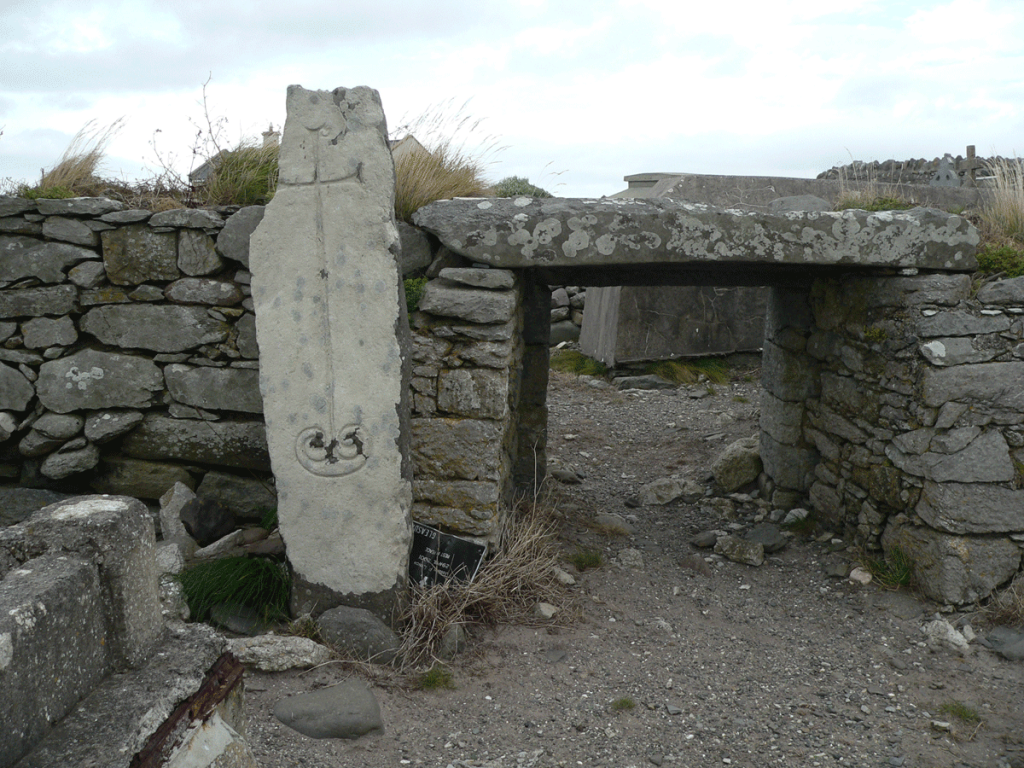
What a remarkable experience to add one’s own hands to the collection of thousands that have traced the engraved path of the cross on that ancient stone.
Cary Meehan, author of A Traveller’s Guide to Sacred Ireland writes:
“In the graveyard is a cross pillar with a fine incised cross with expanded terminals and a double spiral at its base, similar to those at Kilfountain, Kilmalkedar, and Reask.”
Graveyard is Being Reclaimed by the Sea – Bones Everywhere
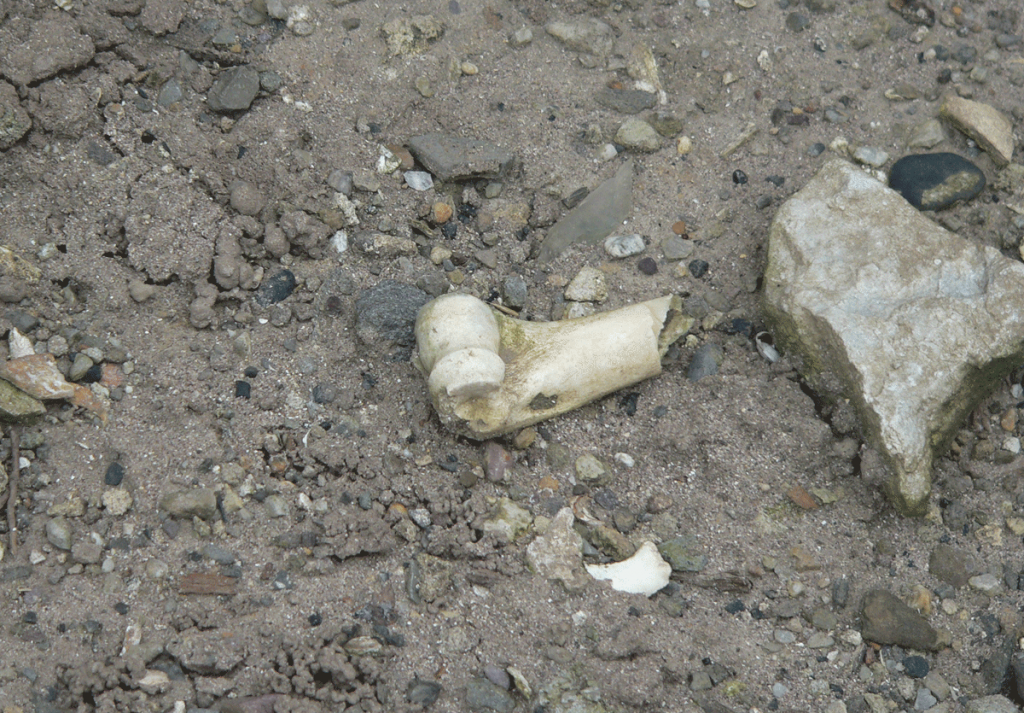
The ruined church was converted to a cemetery as were most of the church ruins in Ireland. And though the church was built on high ground above the sea, Brandon Bay has occasionally eclipsed the banks and invaded some of the old graves. Bones have washed out of the graves and litter the area in and around the church. While it was a somewhat macabre site for us, it was also a reminder that our remains join all the elements of nature eventually. We all return to dust.
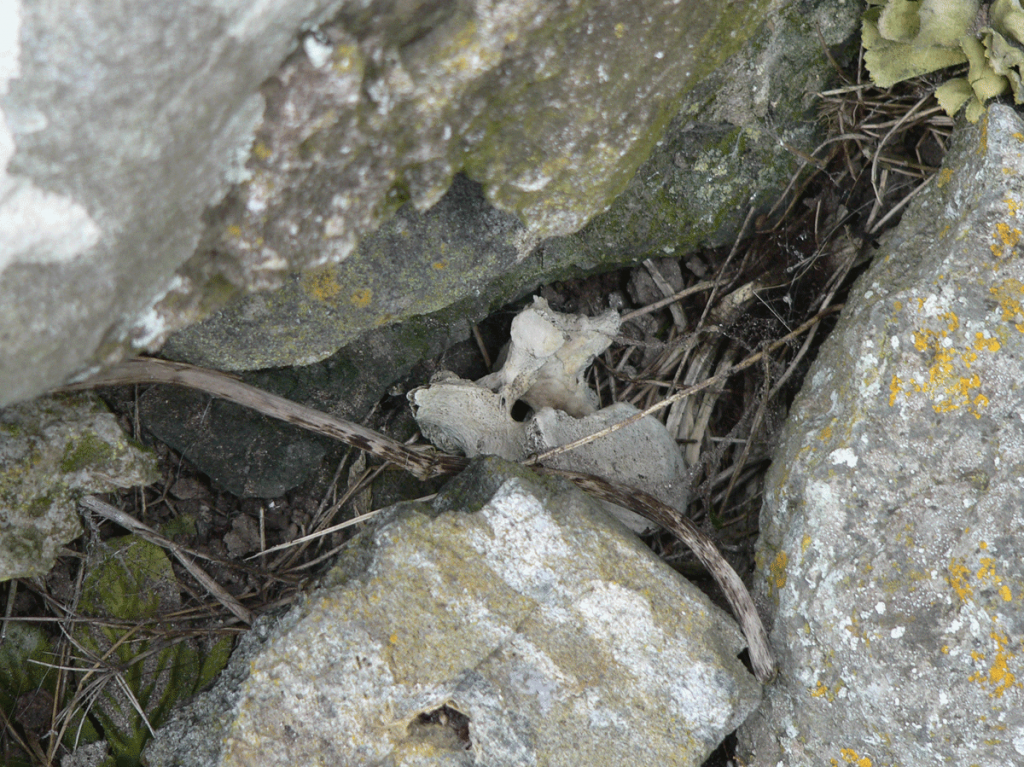
We found some interesting green chards scattered in one place. They had no sharp edges, either glass shards worn down by the sea or some type of stone.
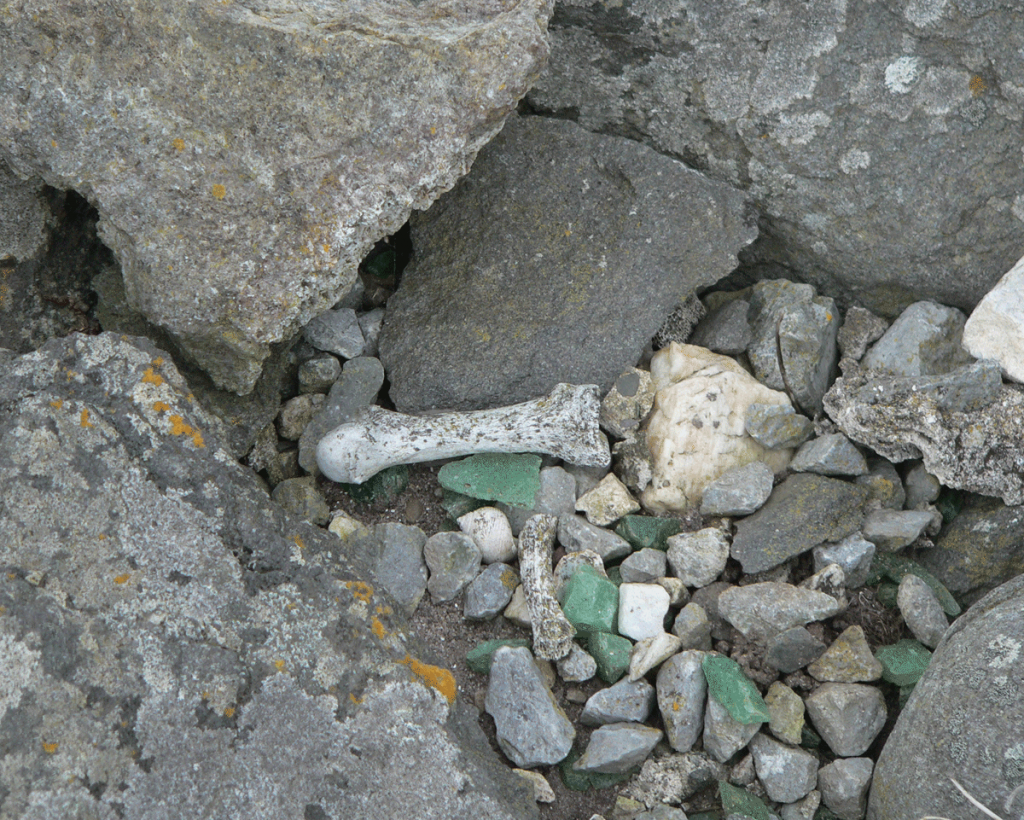
The views from Kilshannig are spectacular. Mount Brandon dominates the western view with Brandon Bay lapping up on a shoreline that extends nearly a half mile out to sea. In the distance, the crashing waves of the Atlantic Ocean can be seen and heard. The silence of the village – save for the wind and sea – is almost eerie. This is a holy place.
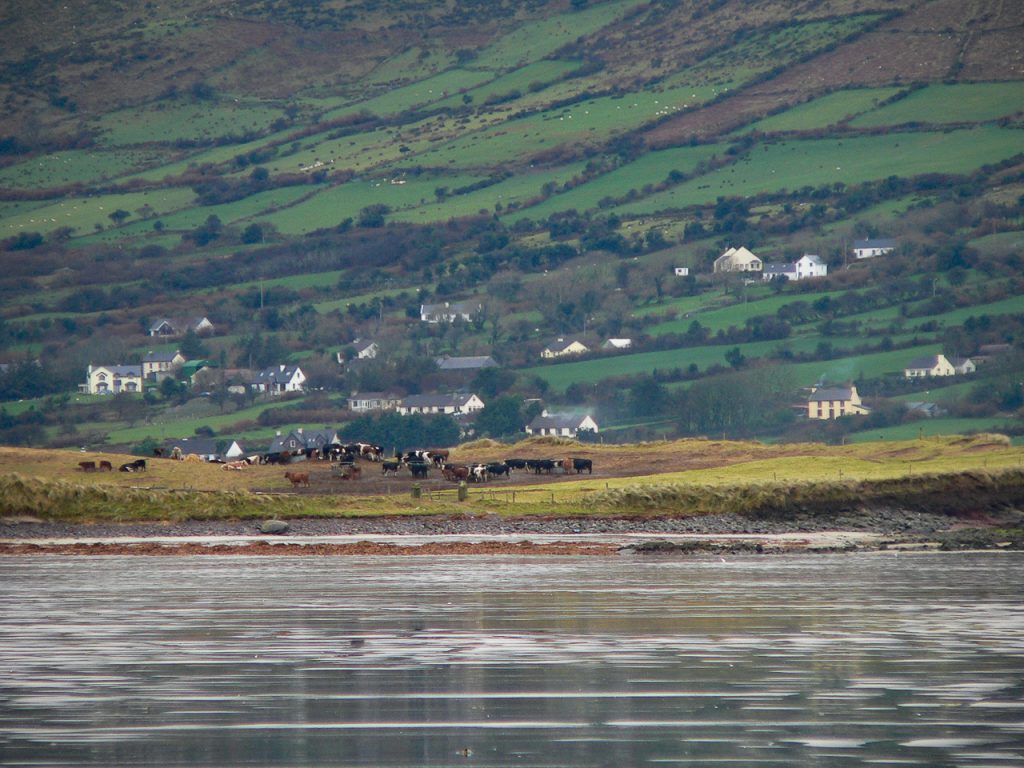
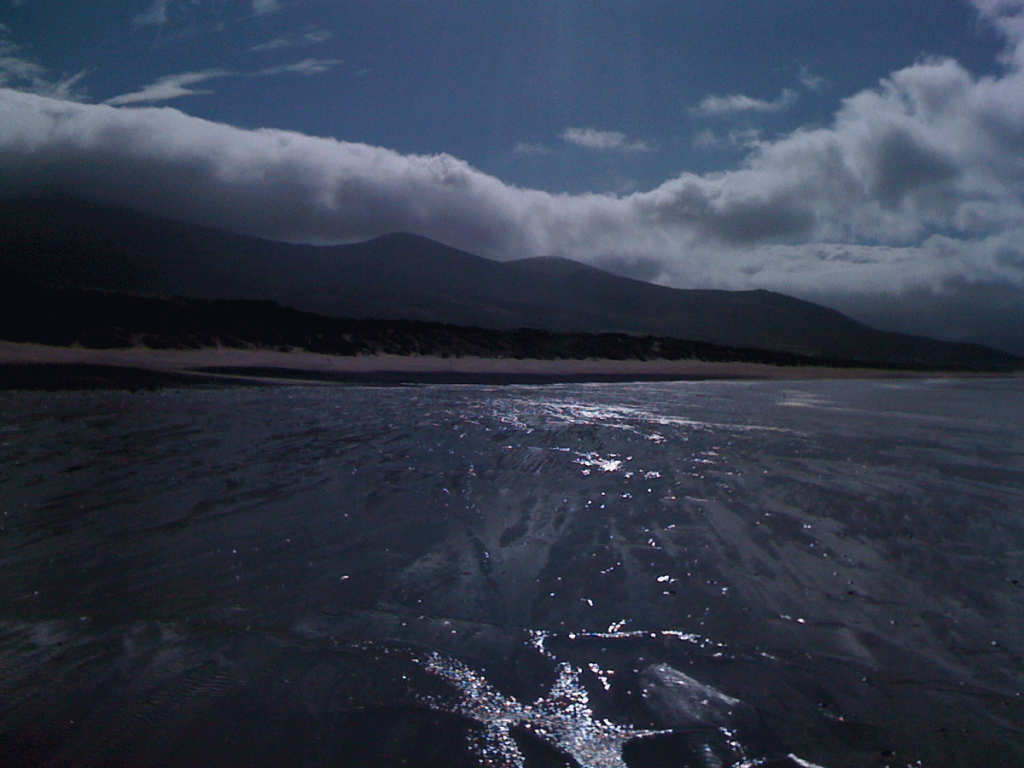
Ardmore in County Waterford – the Oldest Christian Settlement in Ireland
Ardmore is a fishing village in County Waterford – just over the border from County Cork. It is the legendary home of St. Declan who is said to have settled there somewhere between 350 and 420 AD, bringing Christianity to the island even before St. Patrick. If this is true, it makes Ardmore the oldest Christian settlement in Ireland.
Ardmore from the Irish “Aird Mhor” means great height. The ruins of a 13 century church, an 8th century oratory and a well preserved 12th century round tower dominate a hillside overlooking Ardmore Bay, a fitting spot for Ireland’s first monastic community.
Driving up the hillside one sees the 90 foot round tower rear up from the landscape like some old relic. That’s when the “thinness” of the place starts to sink in. Come closer and the ruins of St. Declan’s Church with its carved religious scenes – Adam and Eve in the Garden of Eden, the Judgment of Solomon, the Visit of the Magi – emerge from the ancient landscape. The scenes were used to help teach the local community about the Christian faith. This carved church wall is three hundred years older than the church itself, dating the carvings to the 9th century. The wall was actually brought to the site from another ruined religious site that had fallen into decay, so this spot on the hill at Ardmore is its second home.
Almost unnoticeable is the small 8th century oratory built over the spot where St. Declan is believed to be buried. It lies just below the ruined church – hemmed in by graves, both old and recent. Headstones and grave markers occupy nearly every bit of available ground space around the ruins. Some new shiny granite, some old limestone with faded inscriptions, and some merely jagged stones set atop a lump.
The wild beauty of the landscape around the monastic site is mirrored on the nearby cliffs where a pilgrim’s walkway has been carved out. The path leads to the village and St. Declan’s holy well.
Remnants of by-gone spiritual hunger and discovery still cling to the old ruins at Ardmore. The stones hold the memories of faith, of sorrow, of devastation, of joy, of celebration. It is the presence of those memories stored in the ruins that dissolves the veil separating the past, present and eternal worlds. All are knitted together and the elements – the sky, the wind, the sea, the stones – seem brighter, and somehow more vivid.
Ardmore is a thin place, and is on our Thin Places Mystical Tour of Ireland this September. Come join us.
